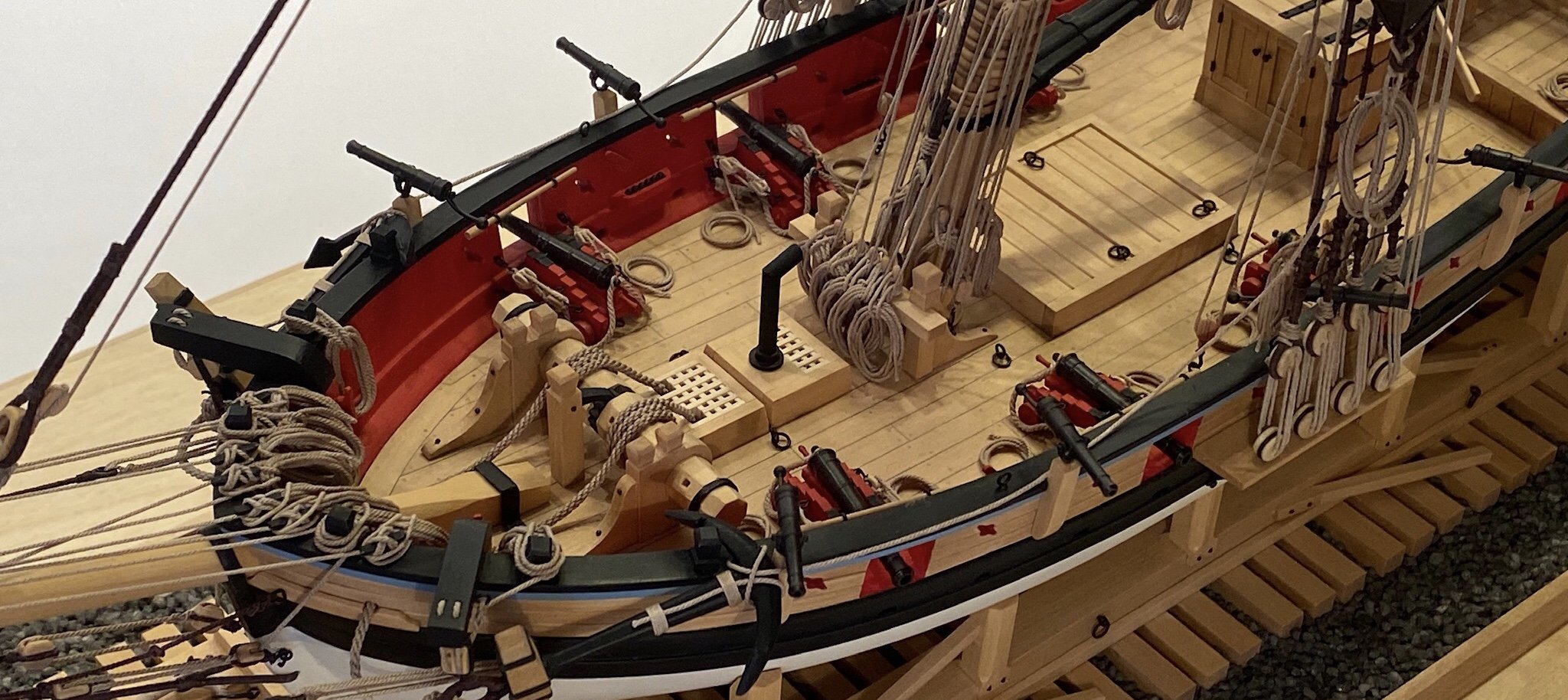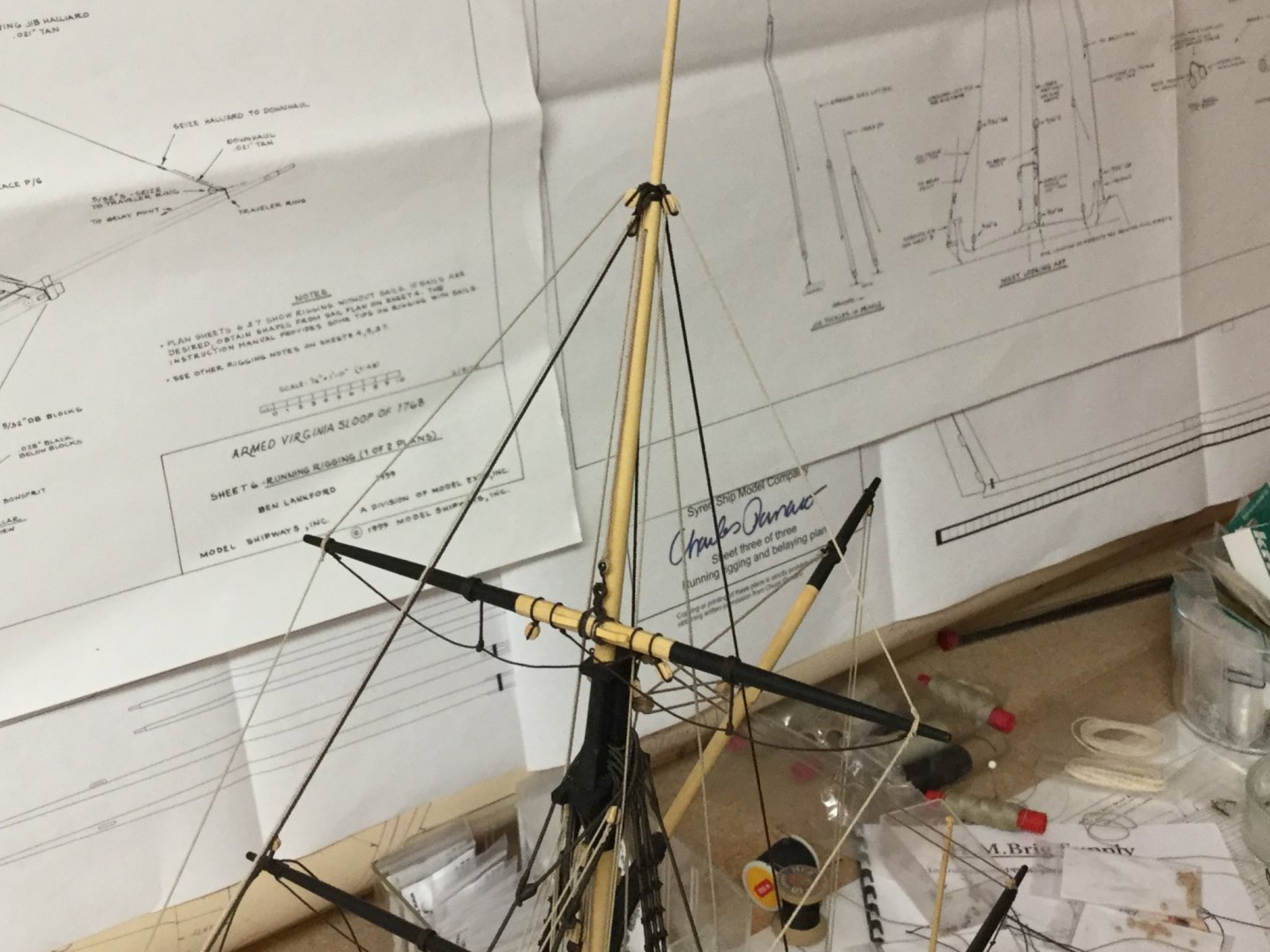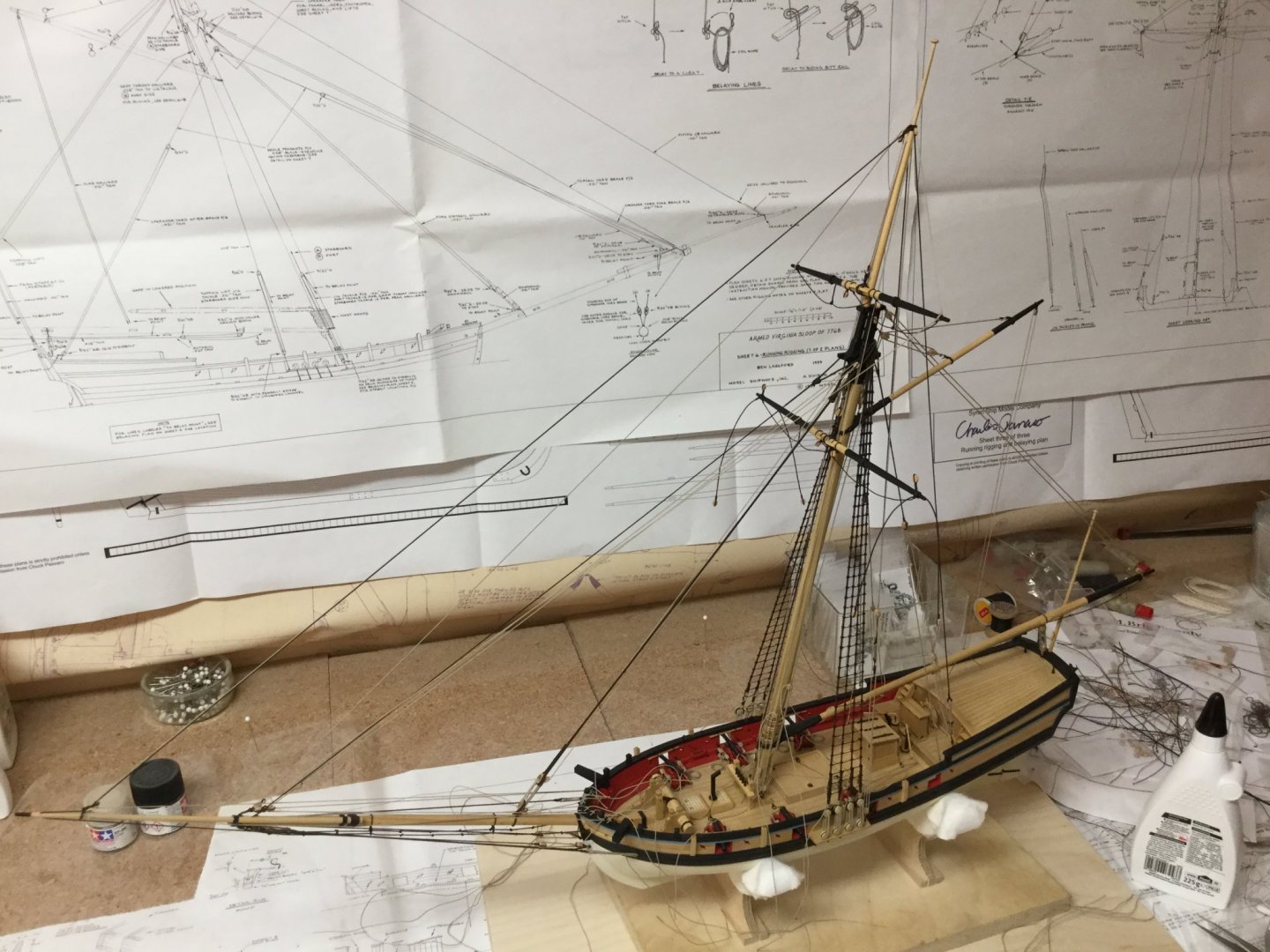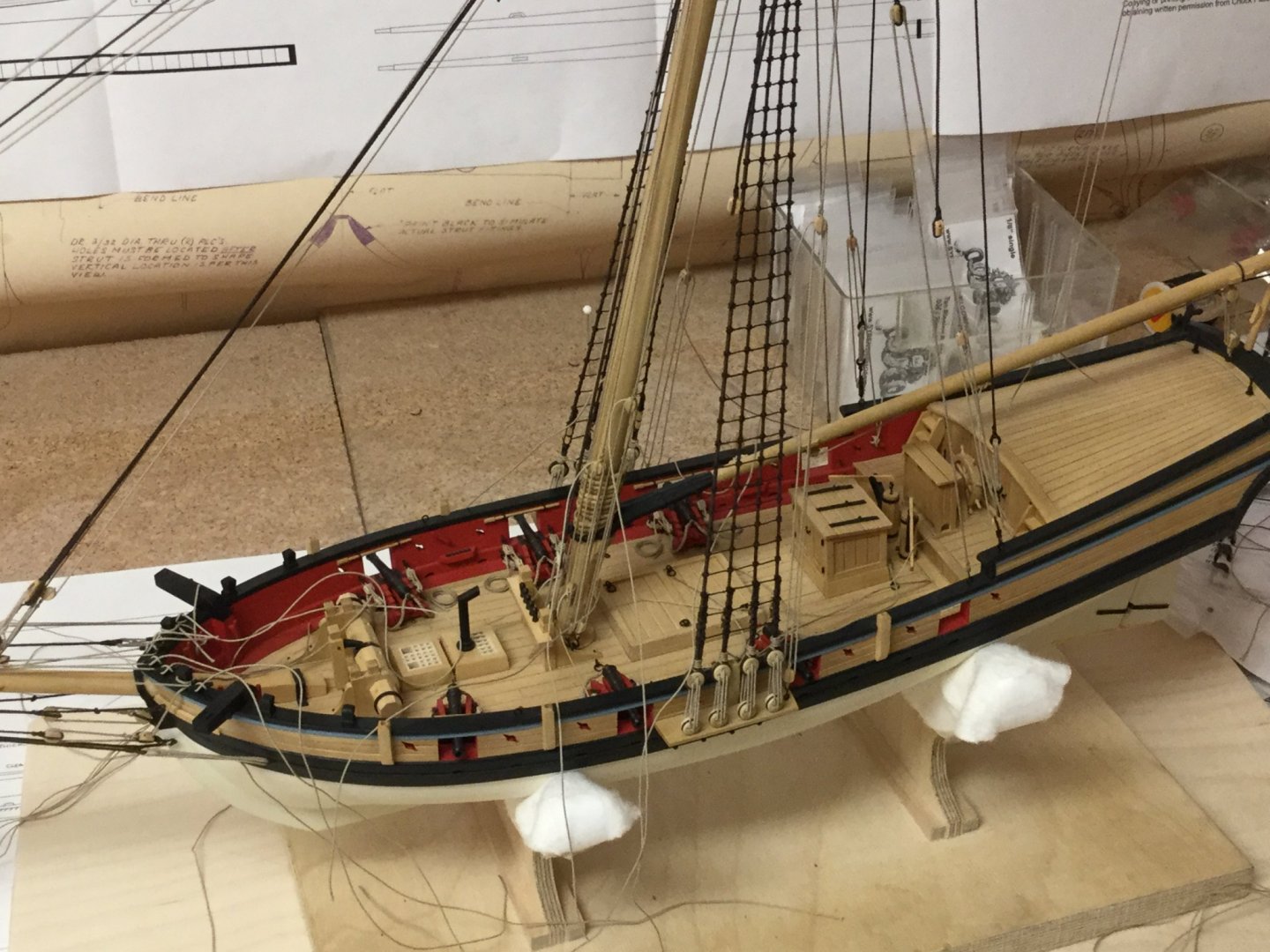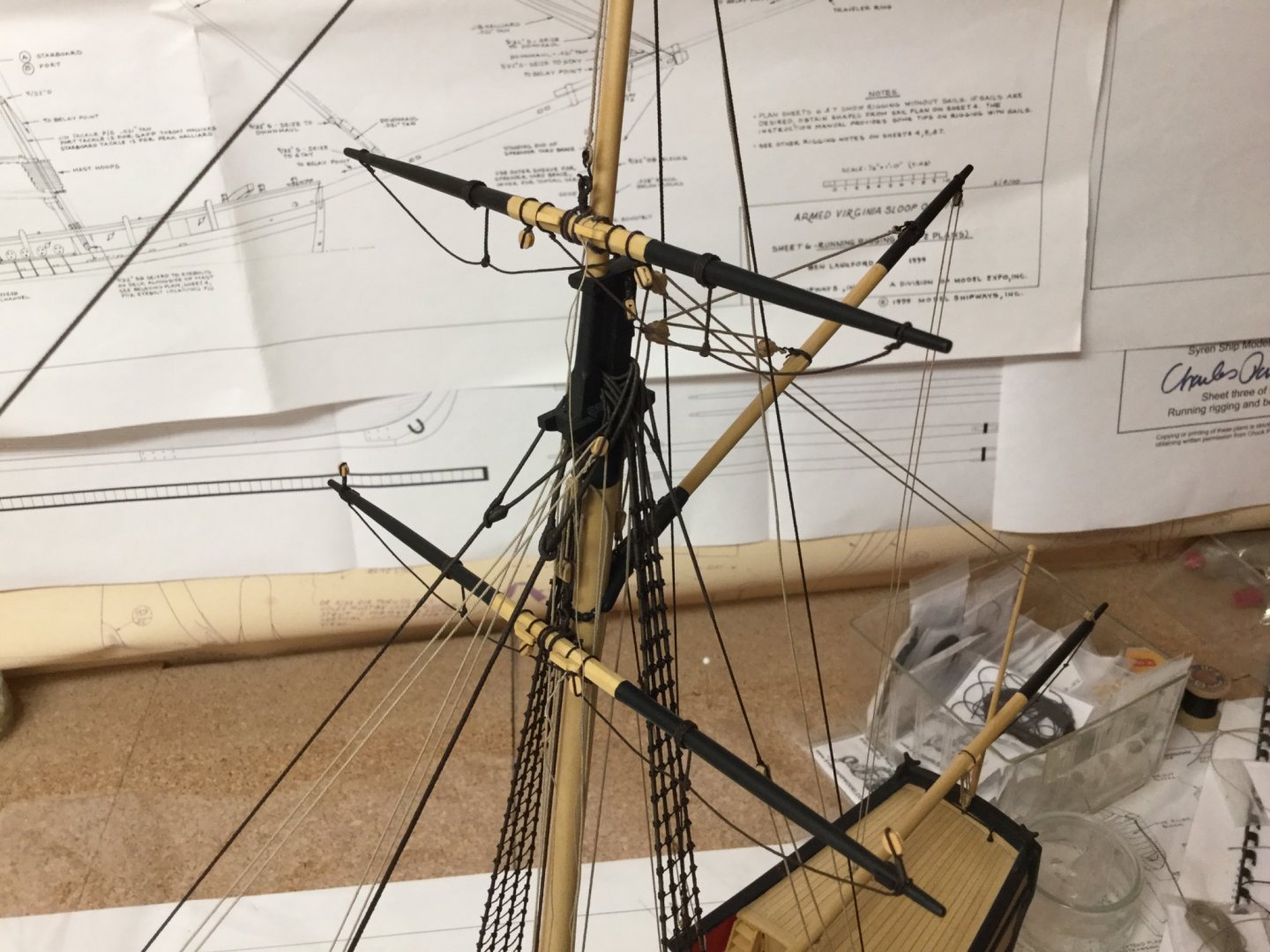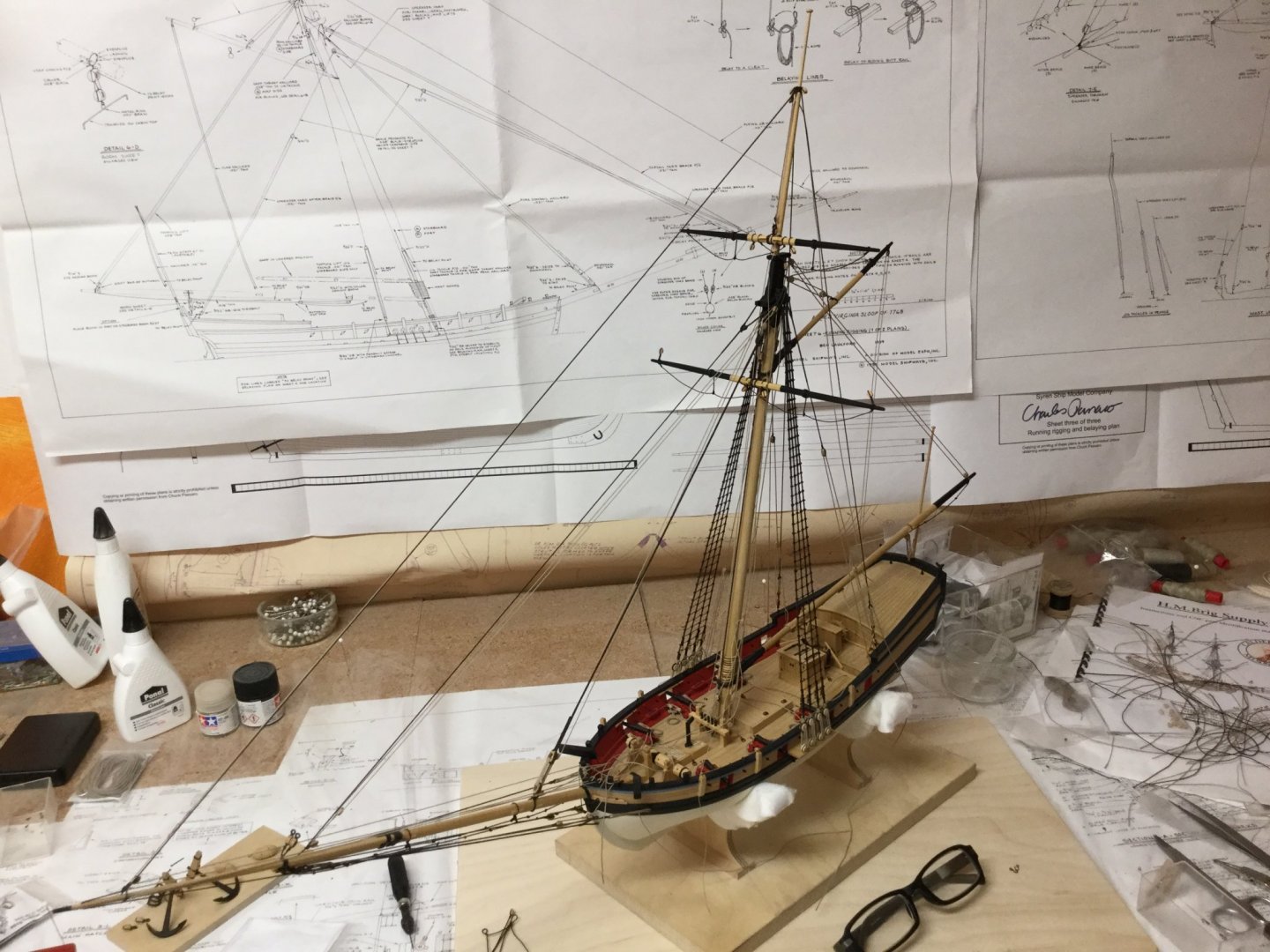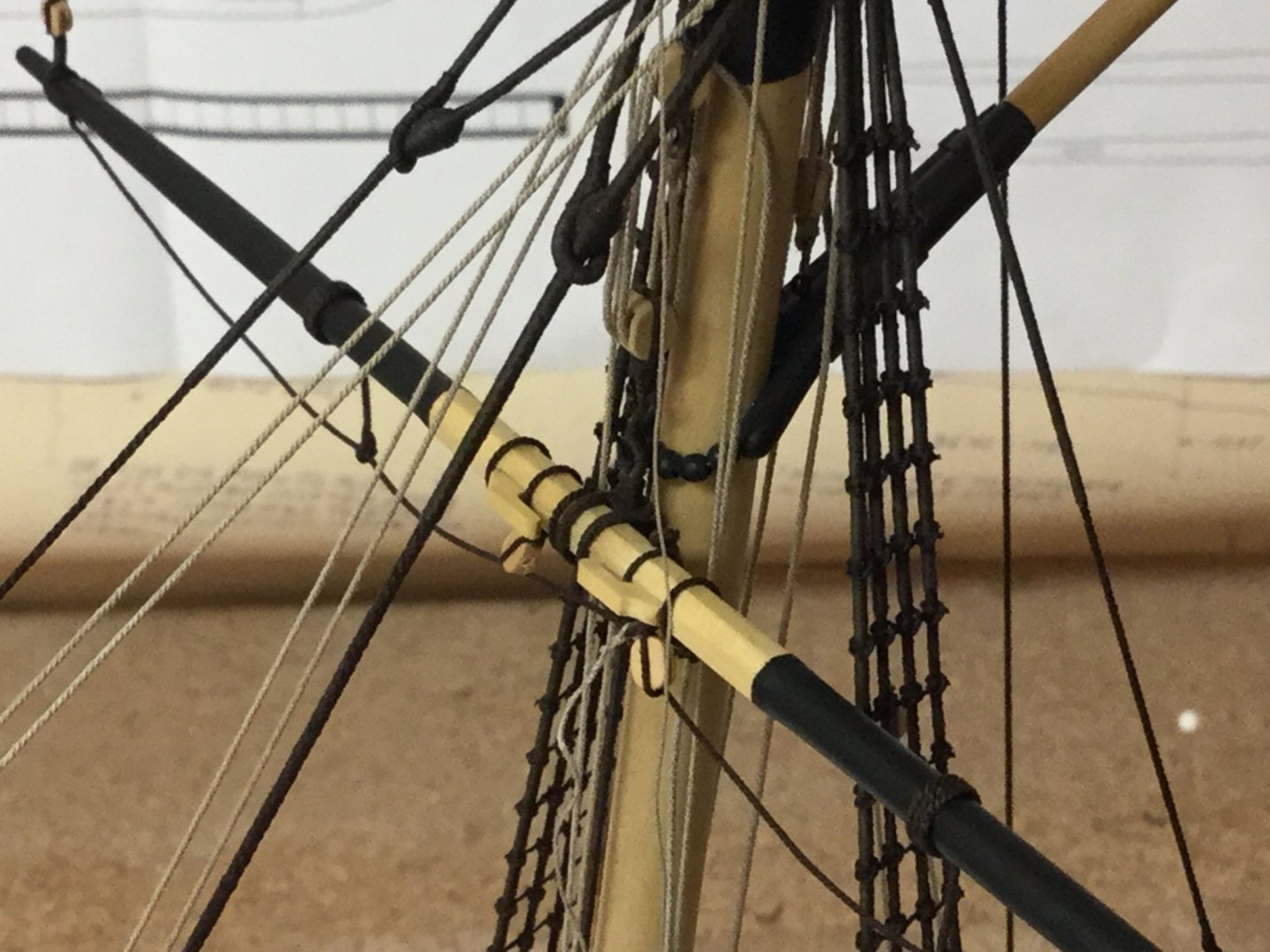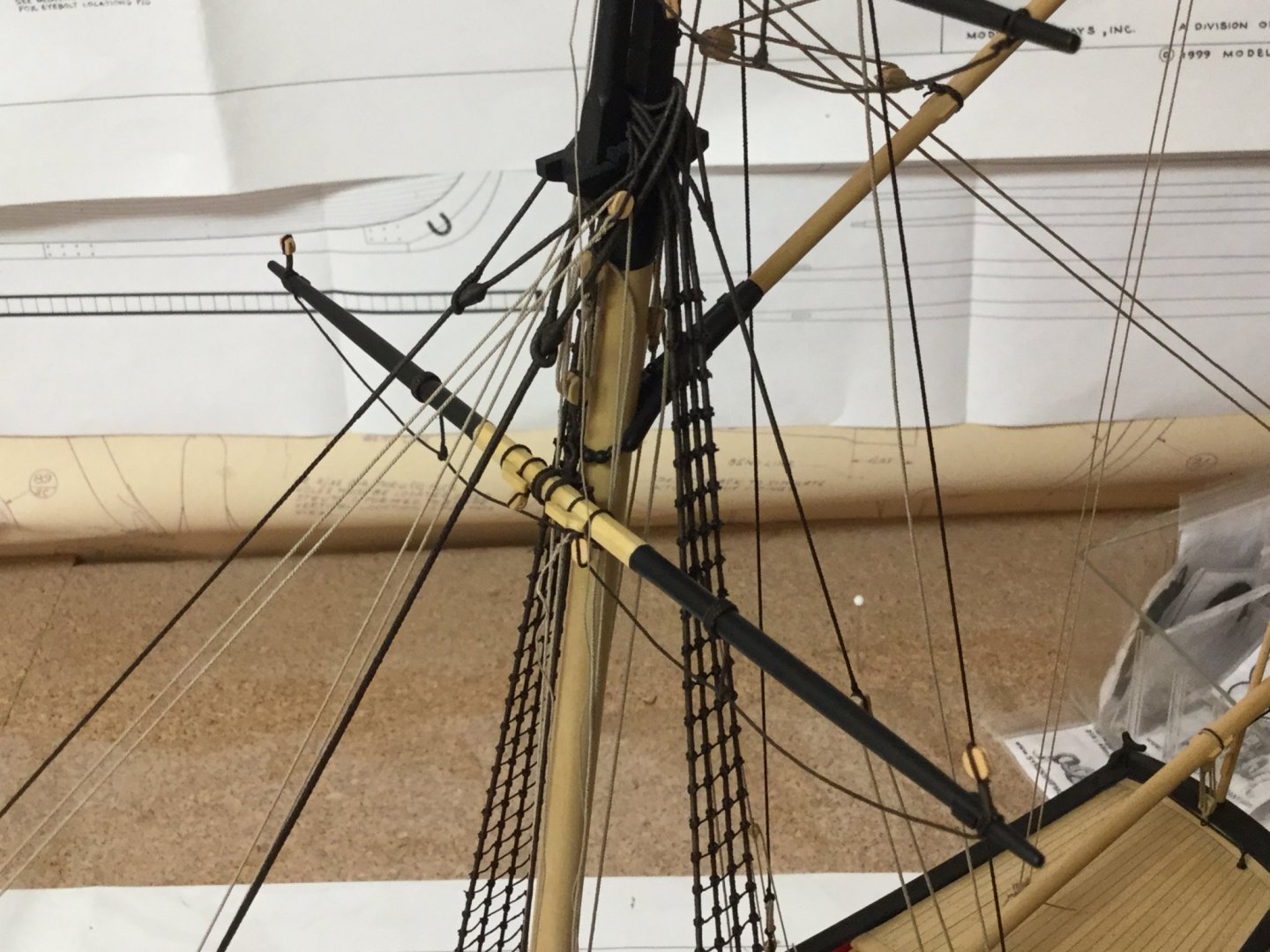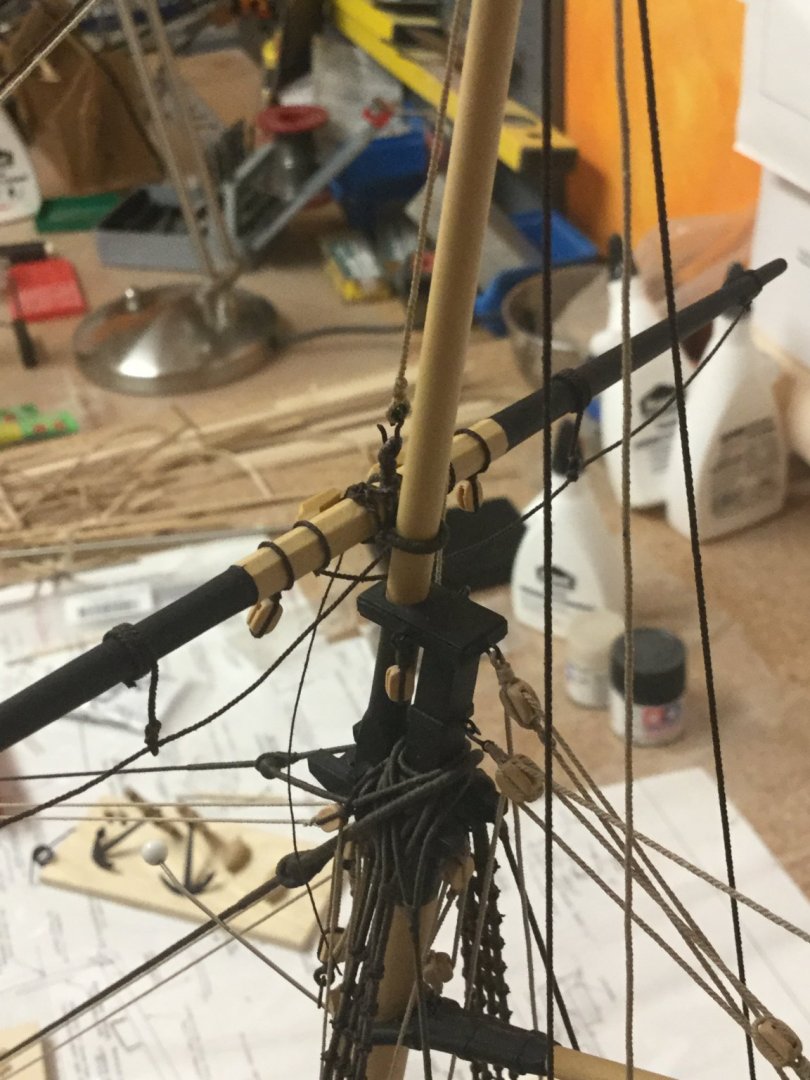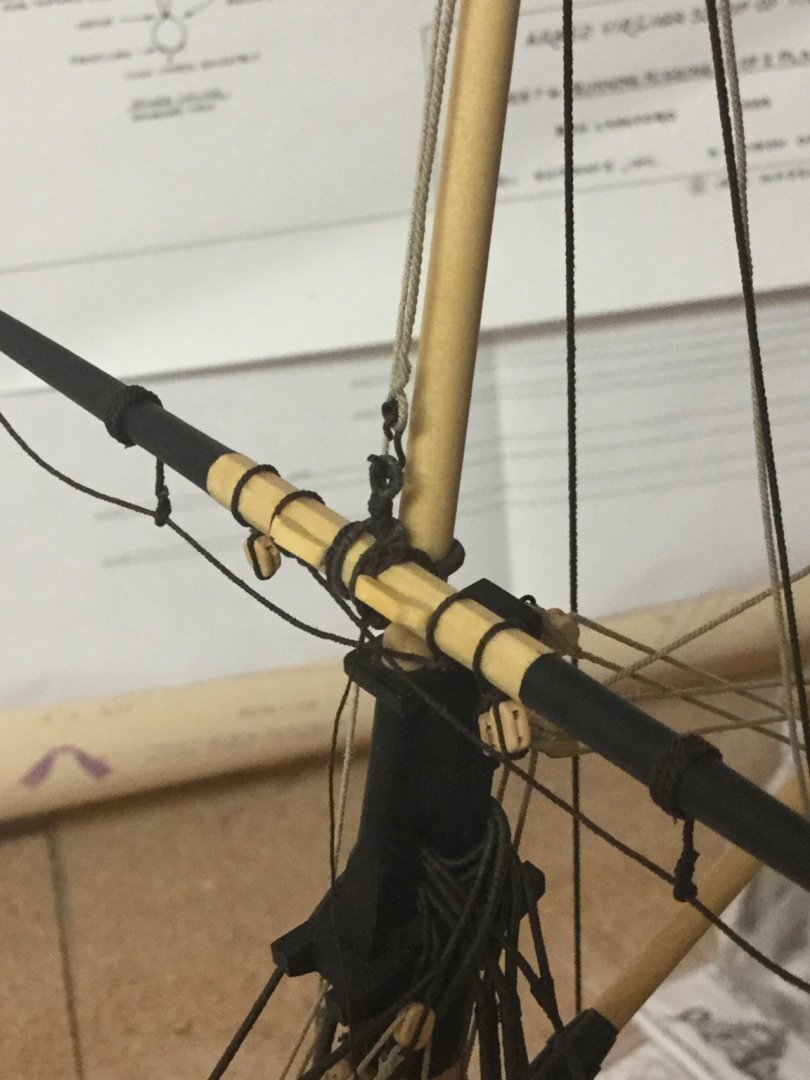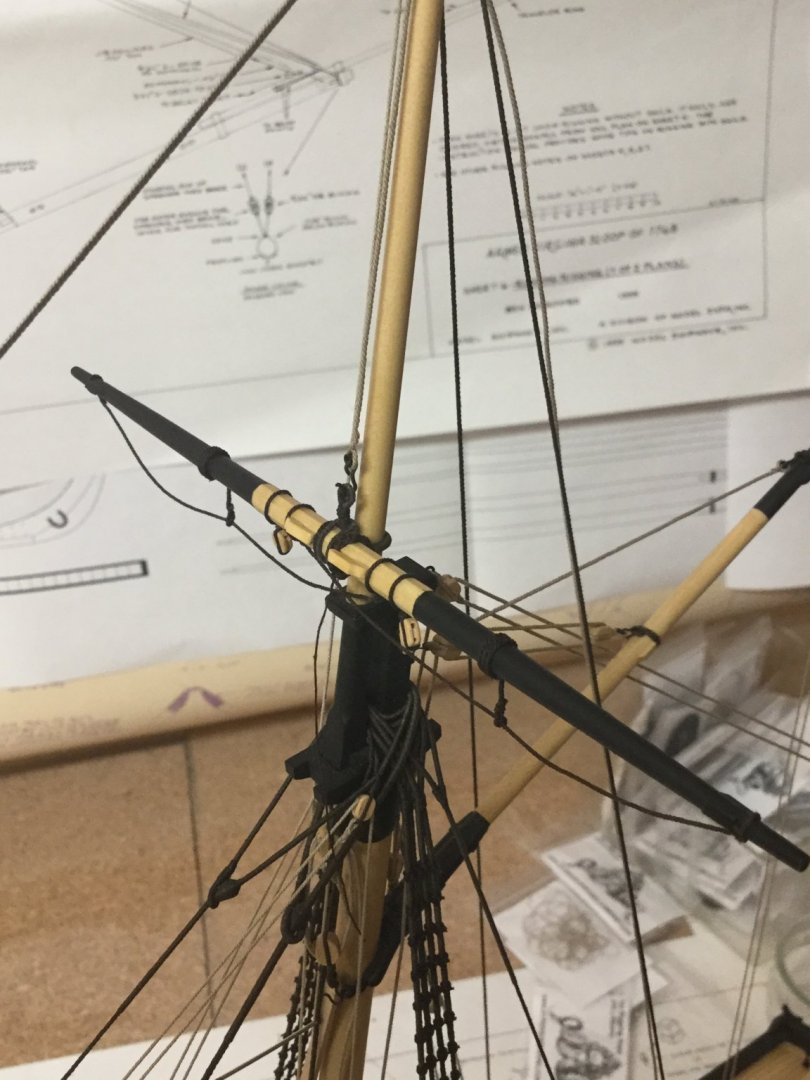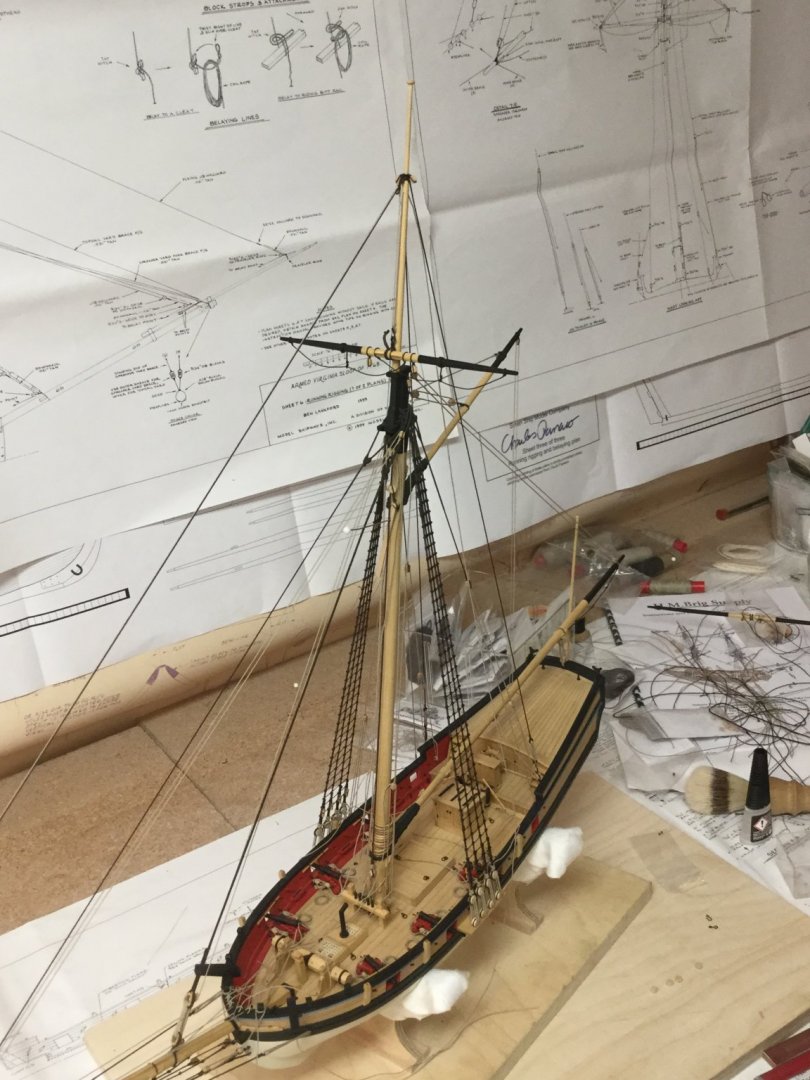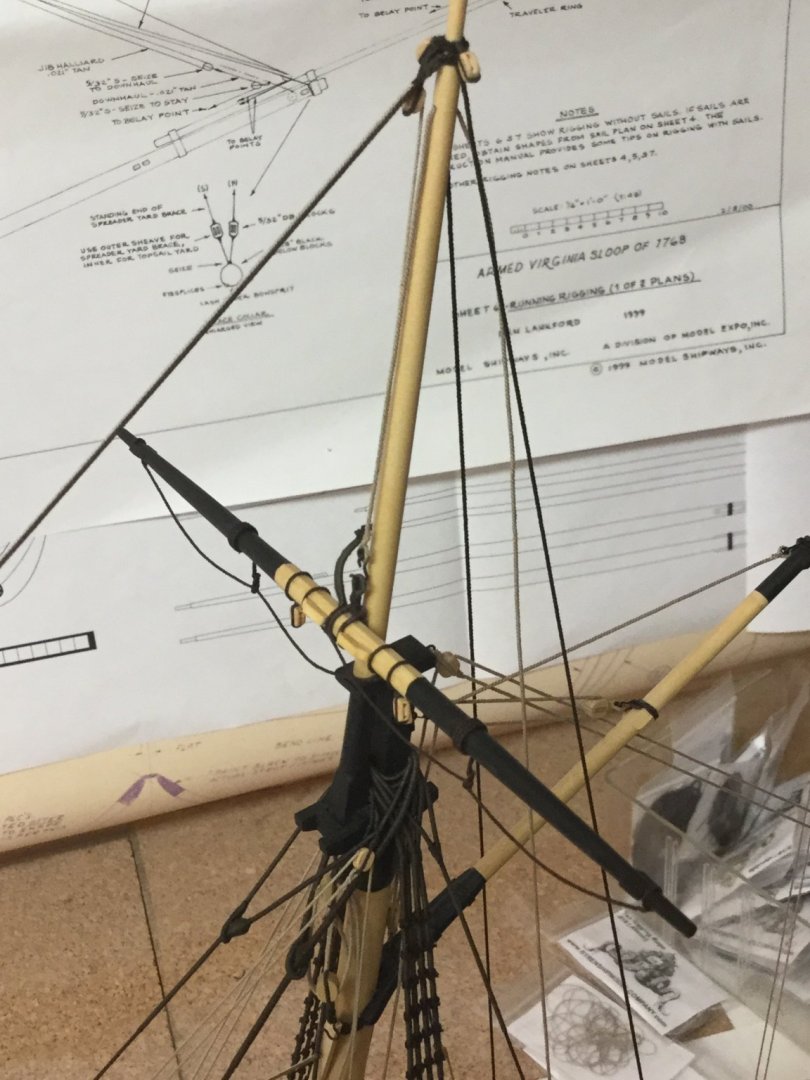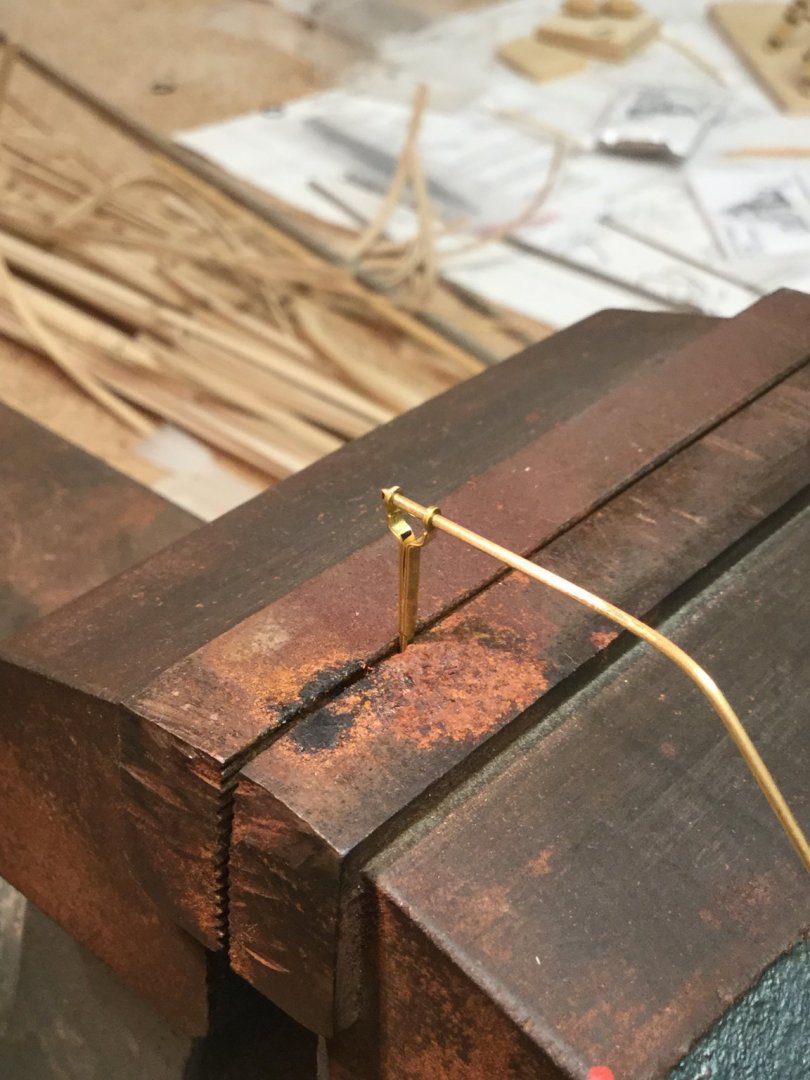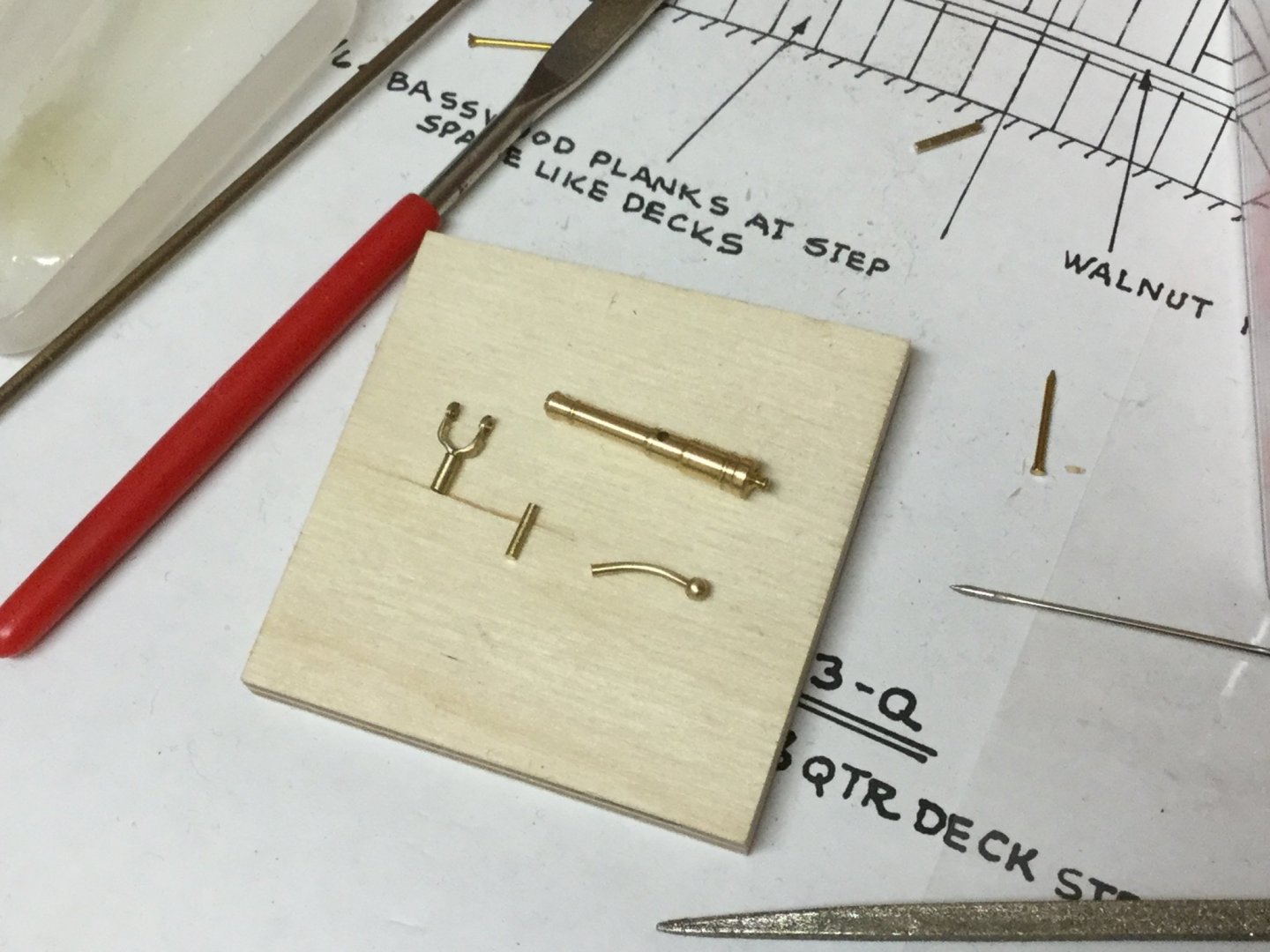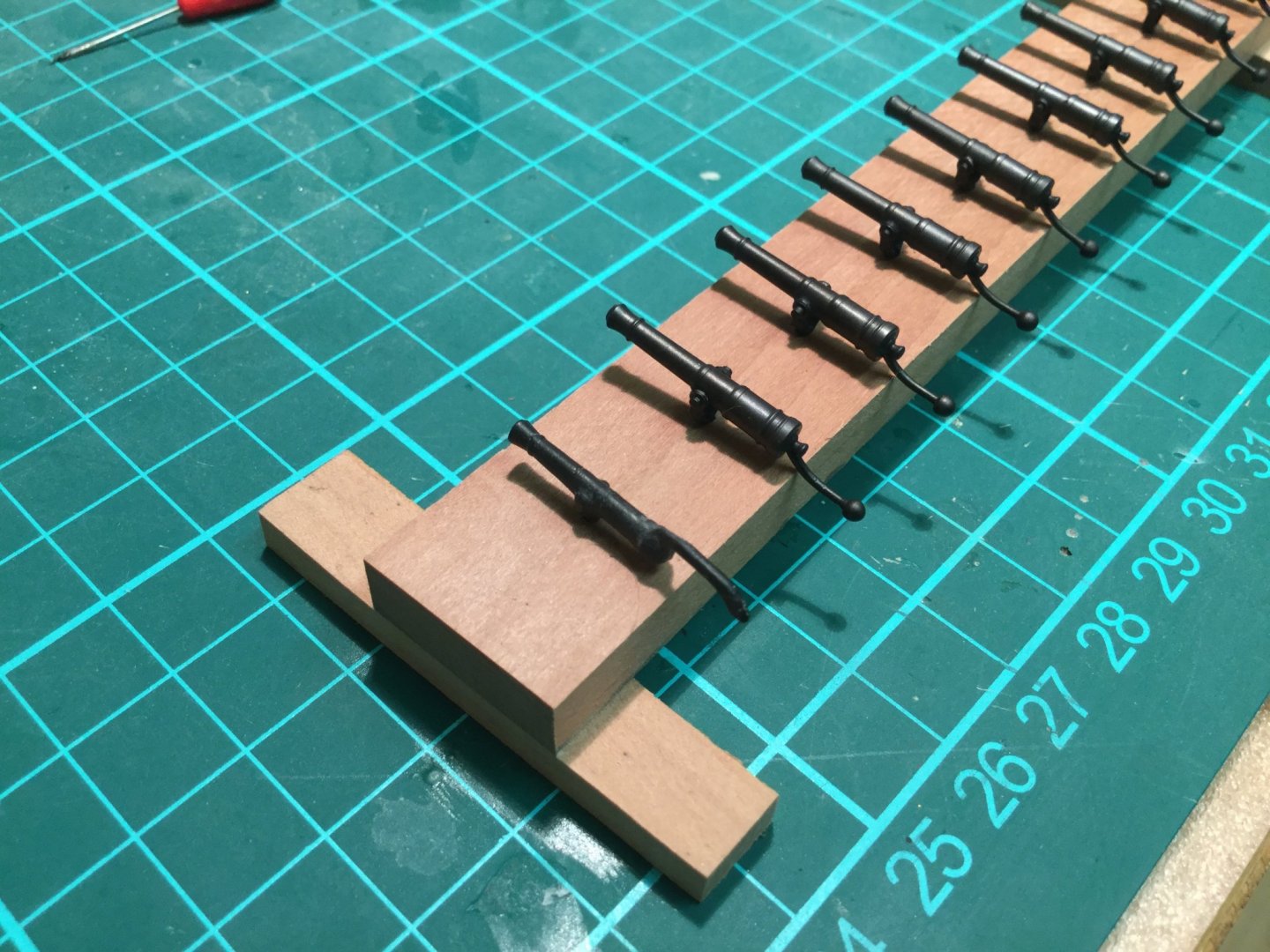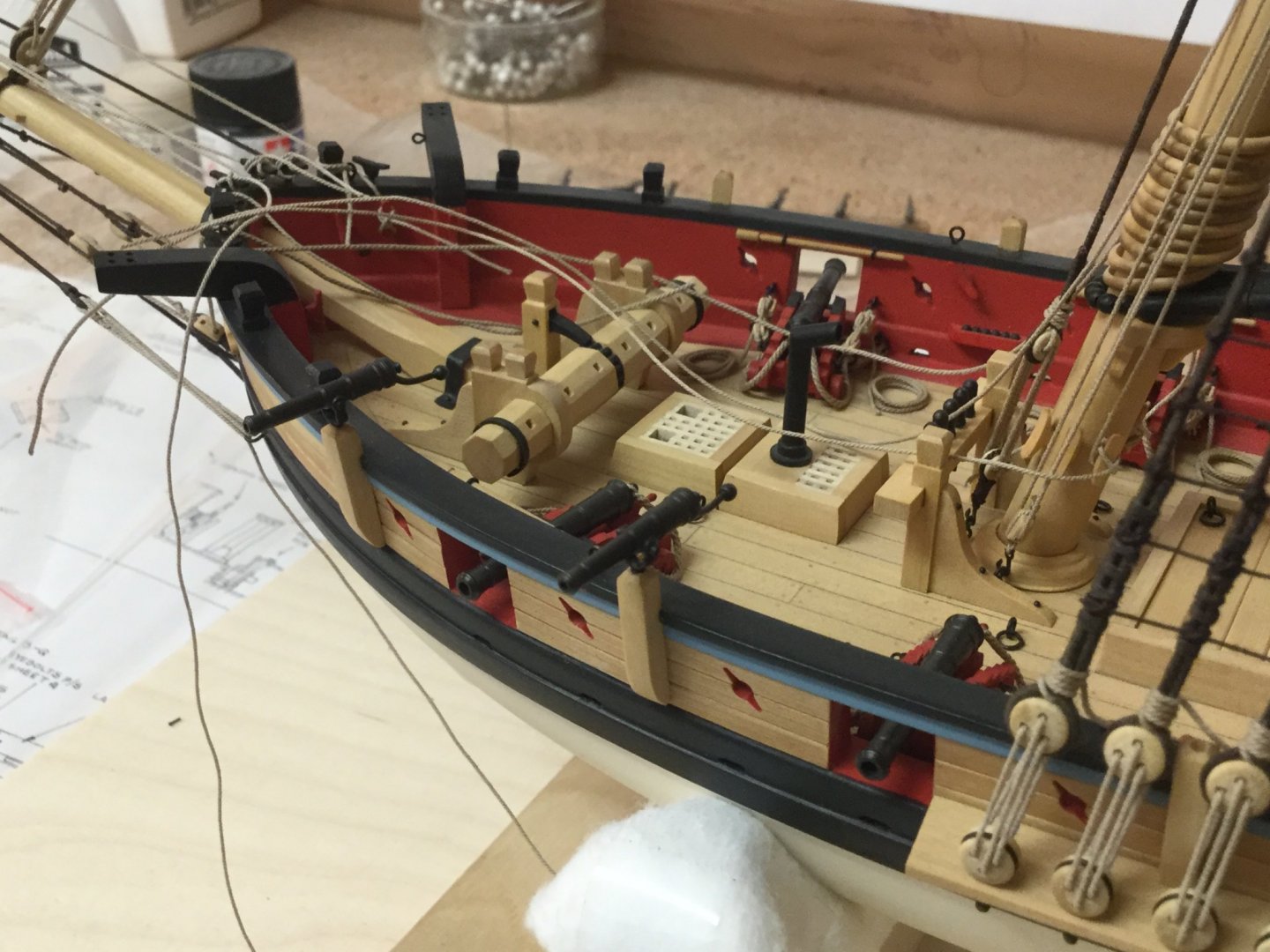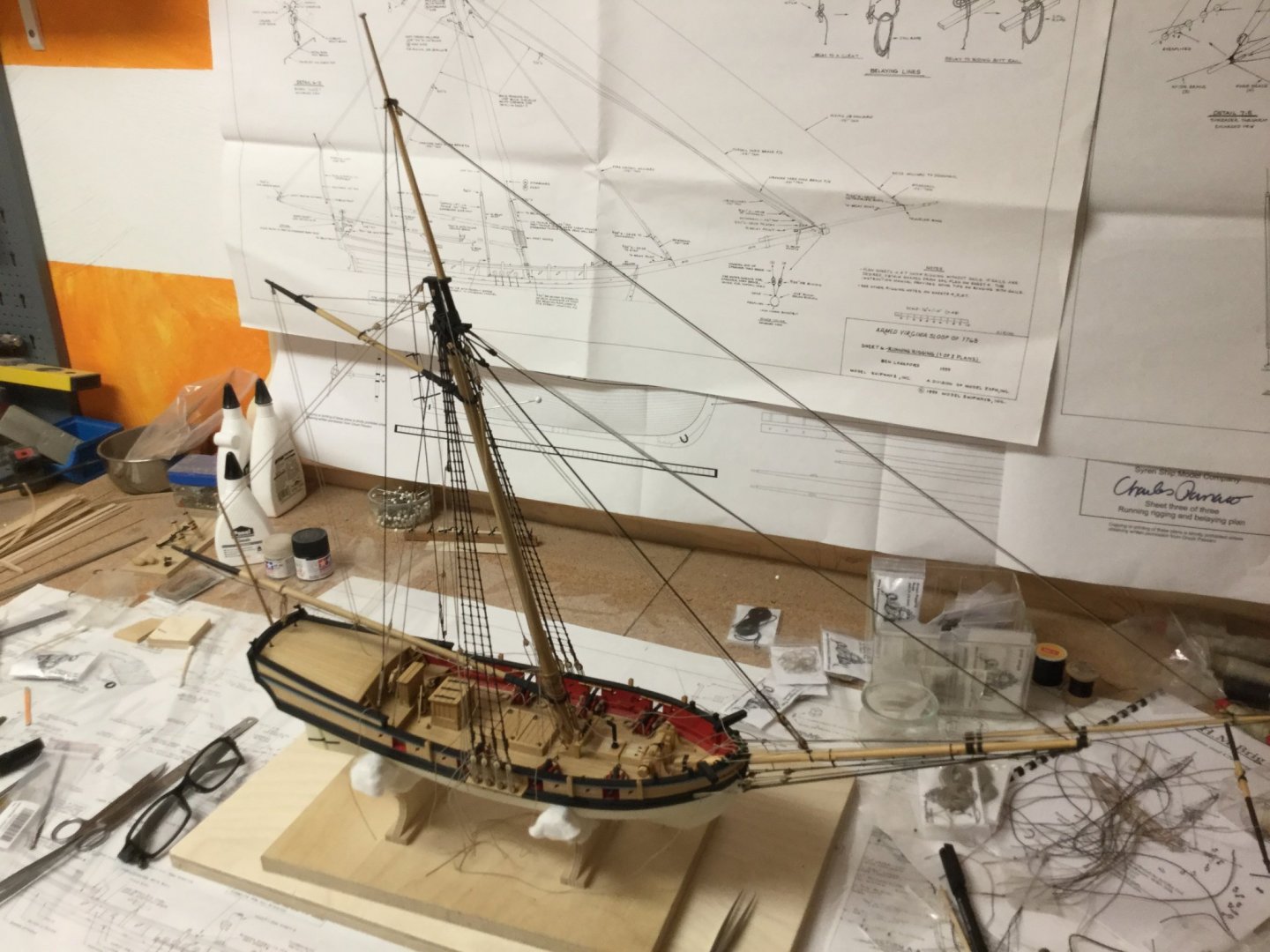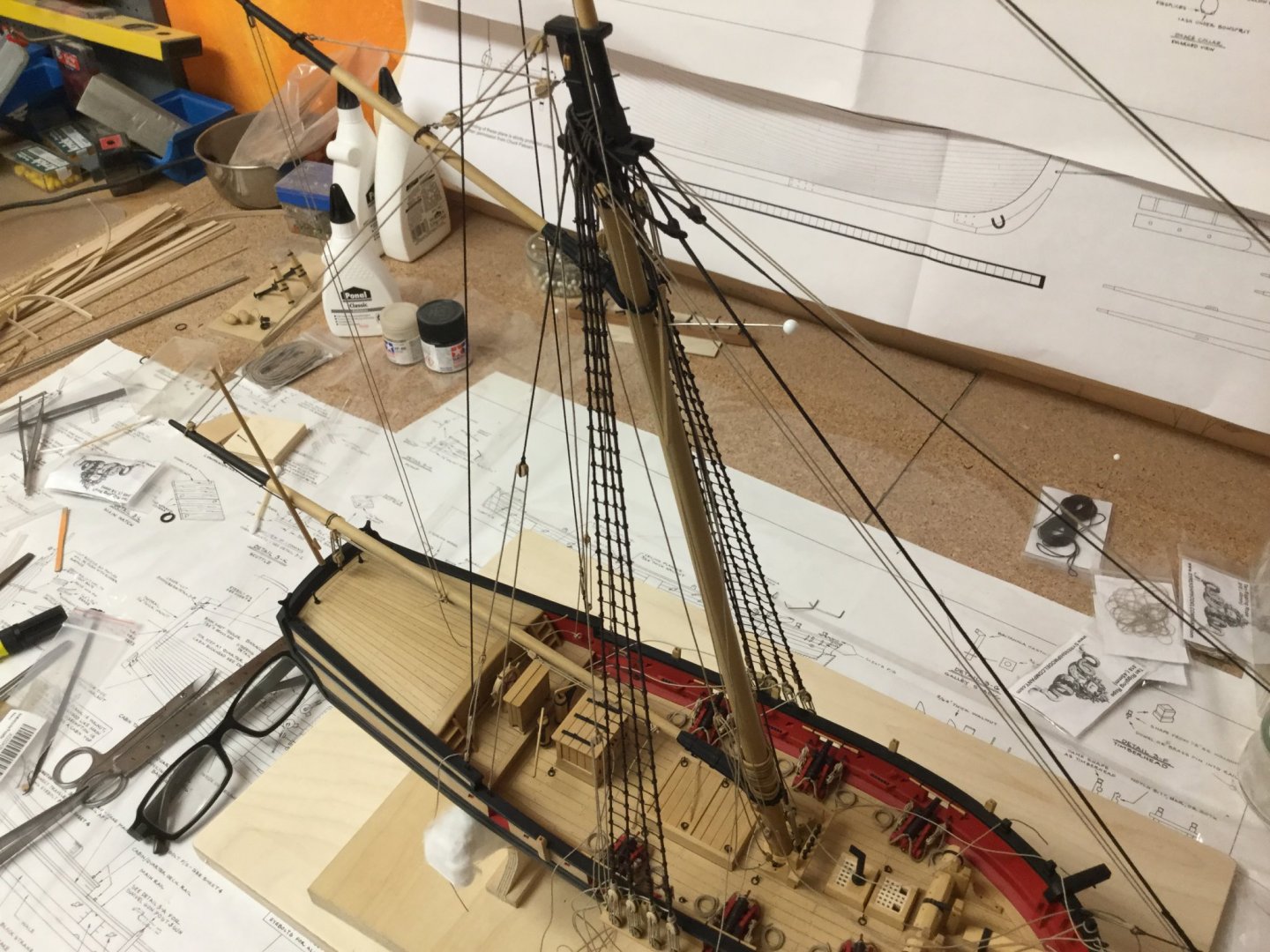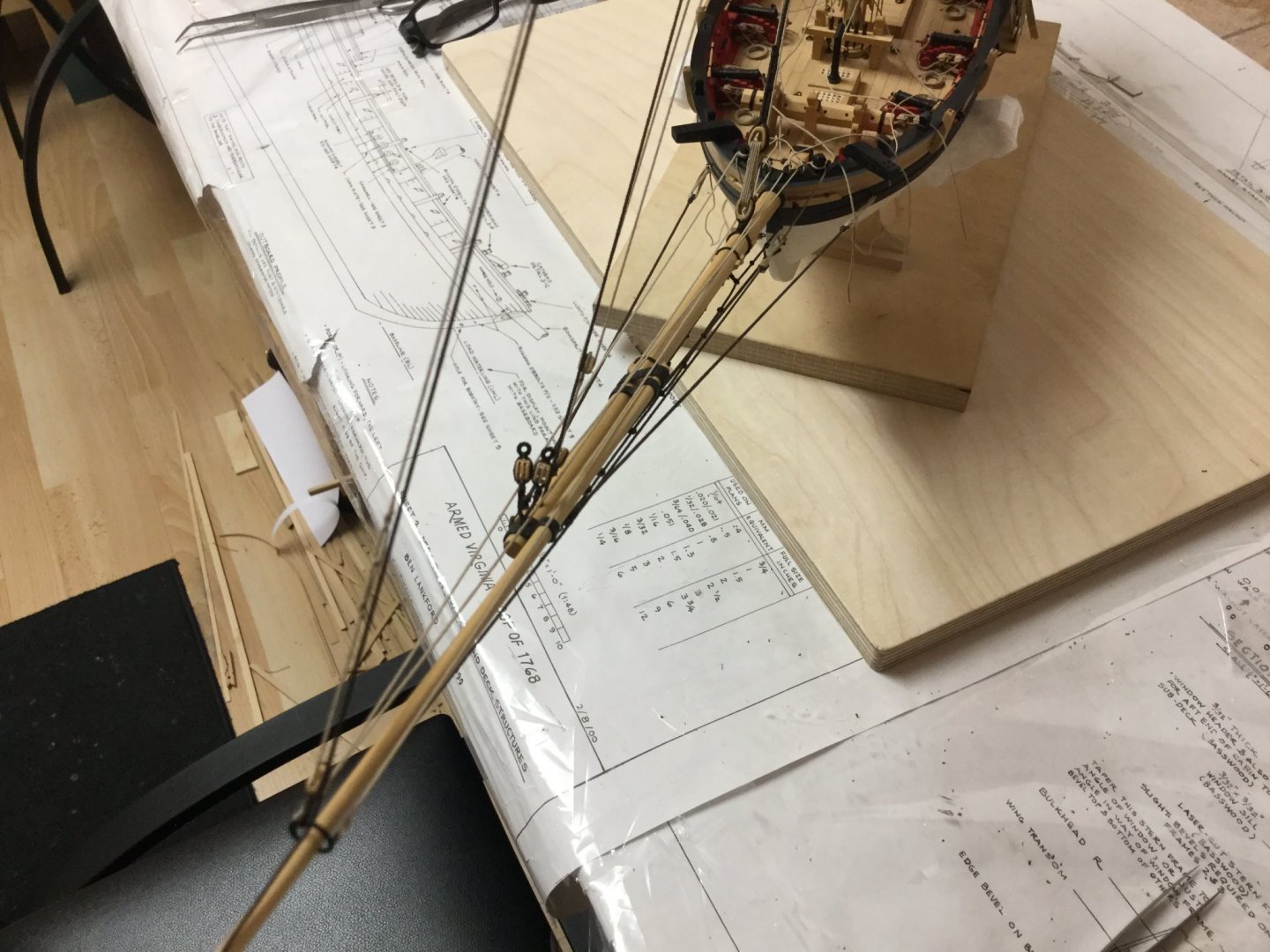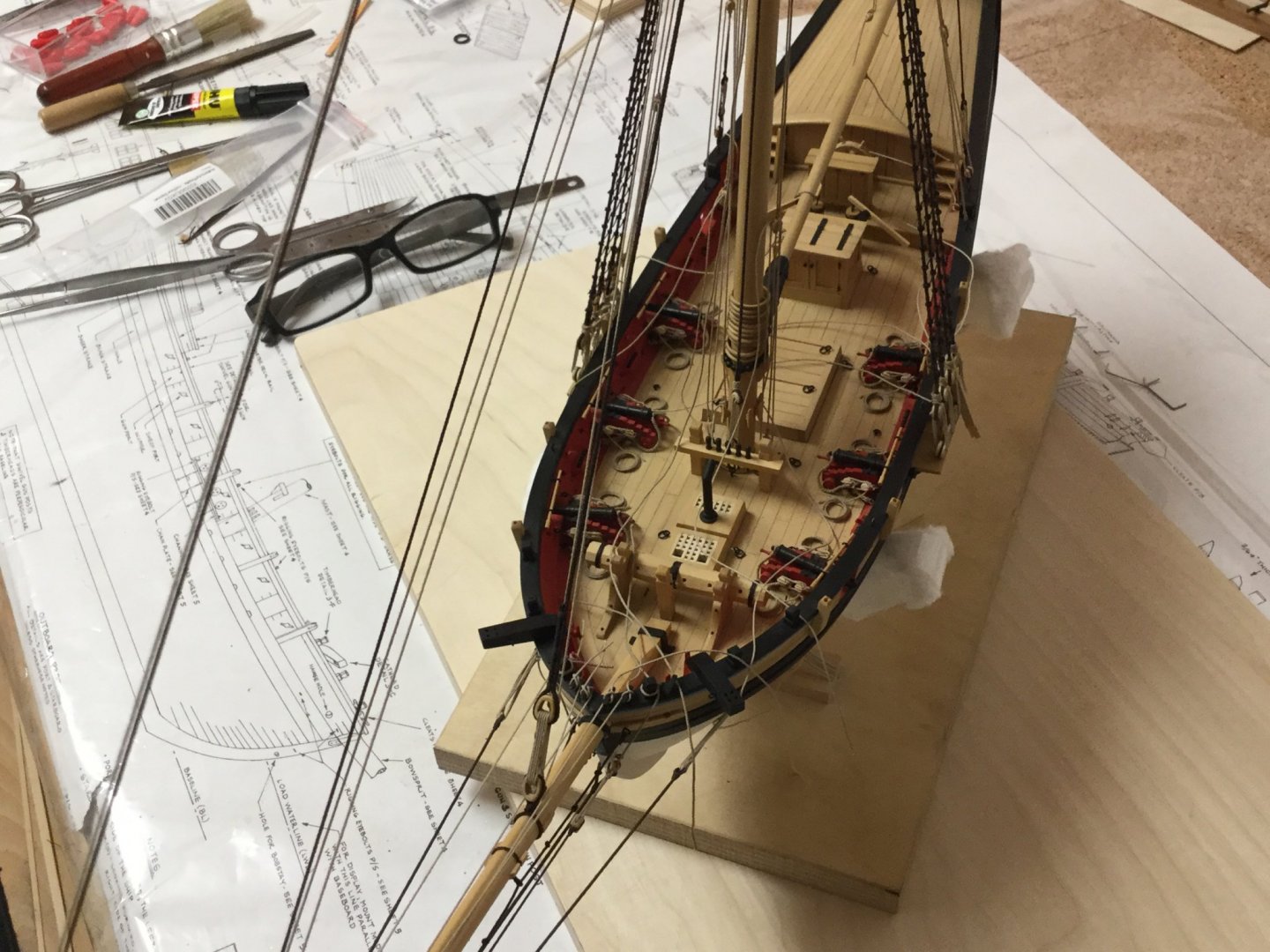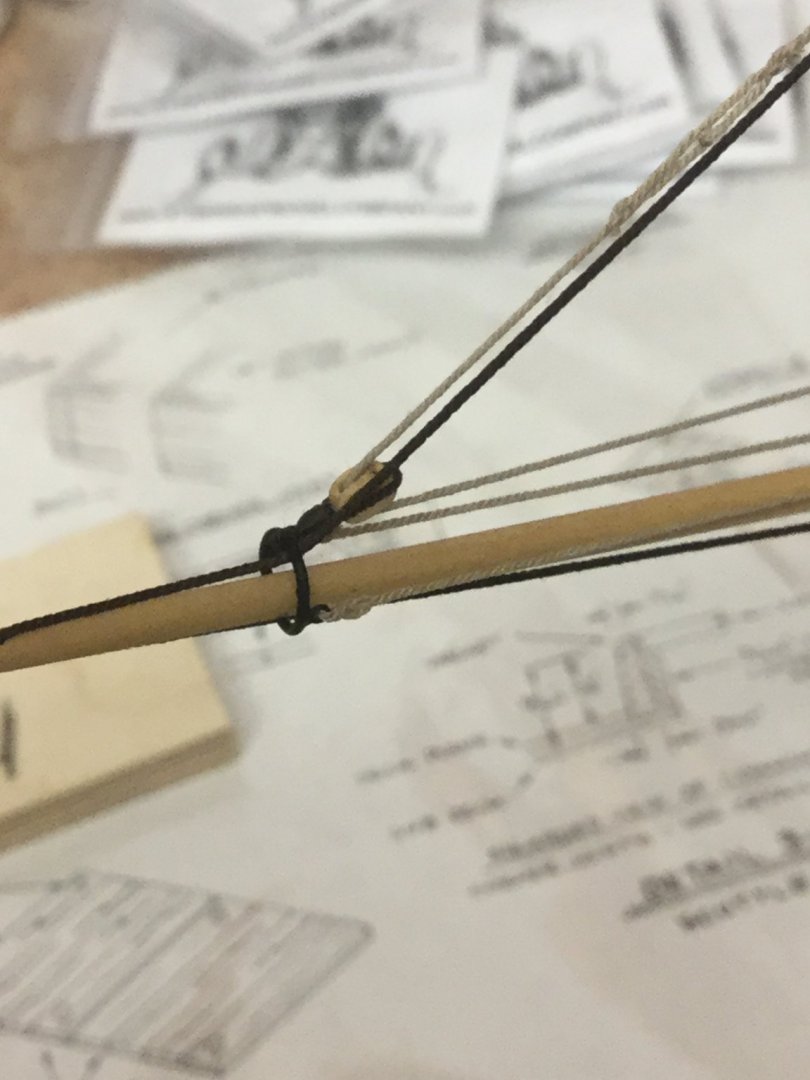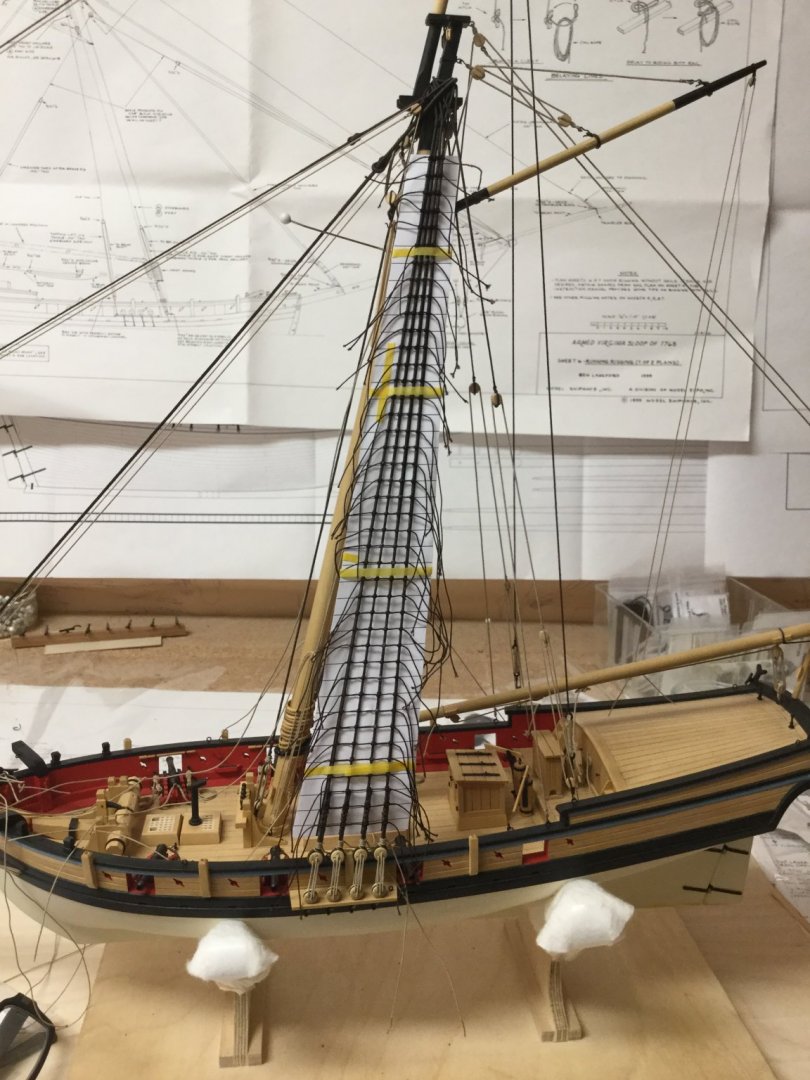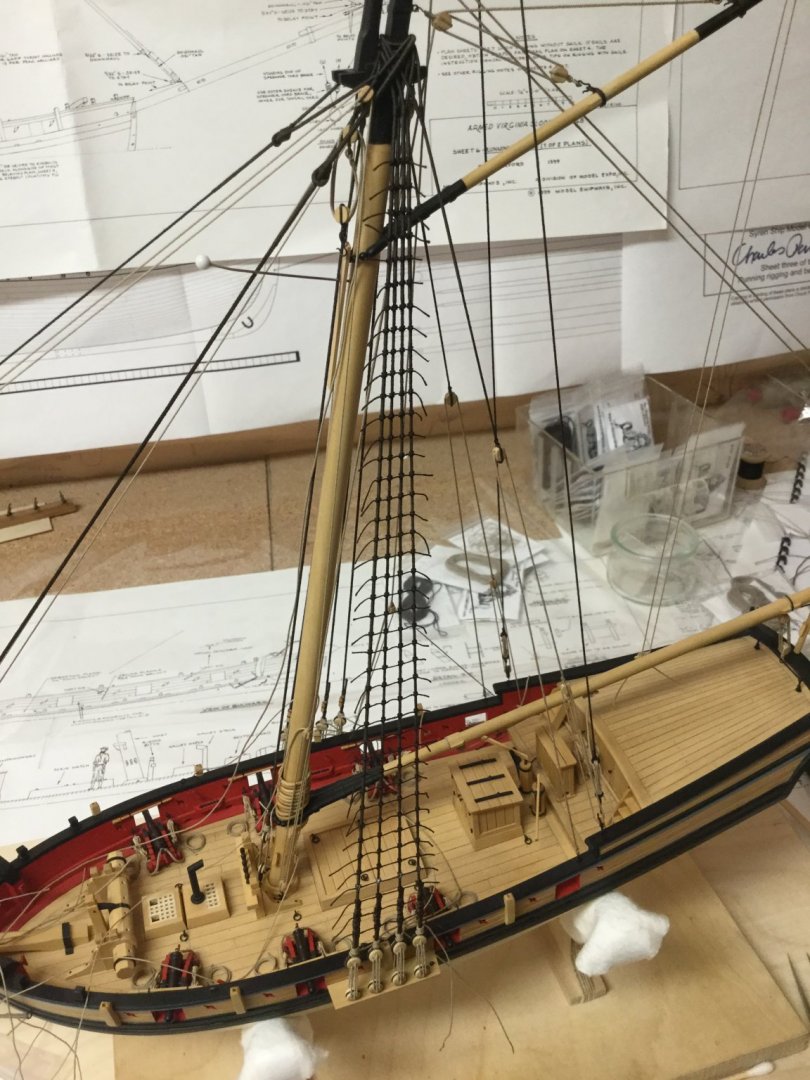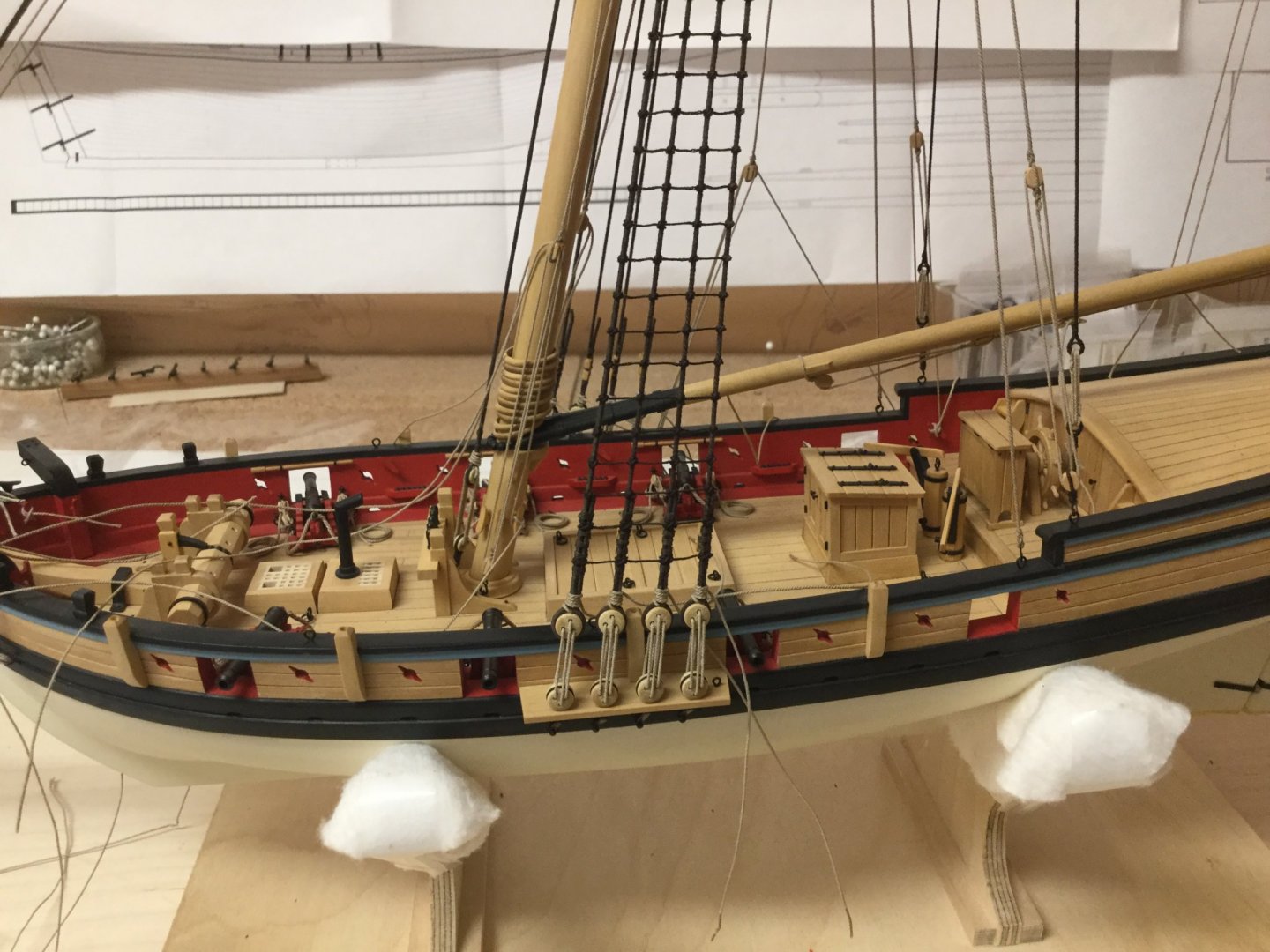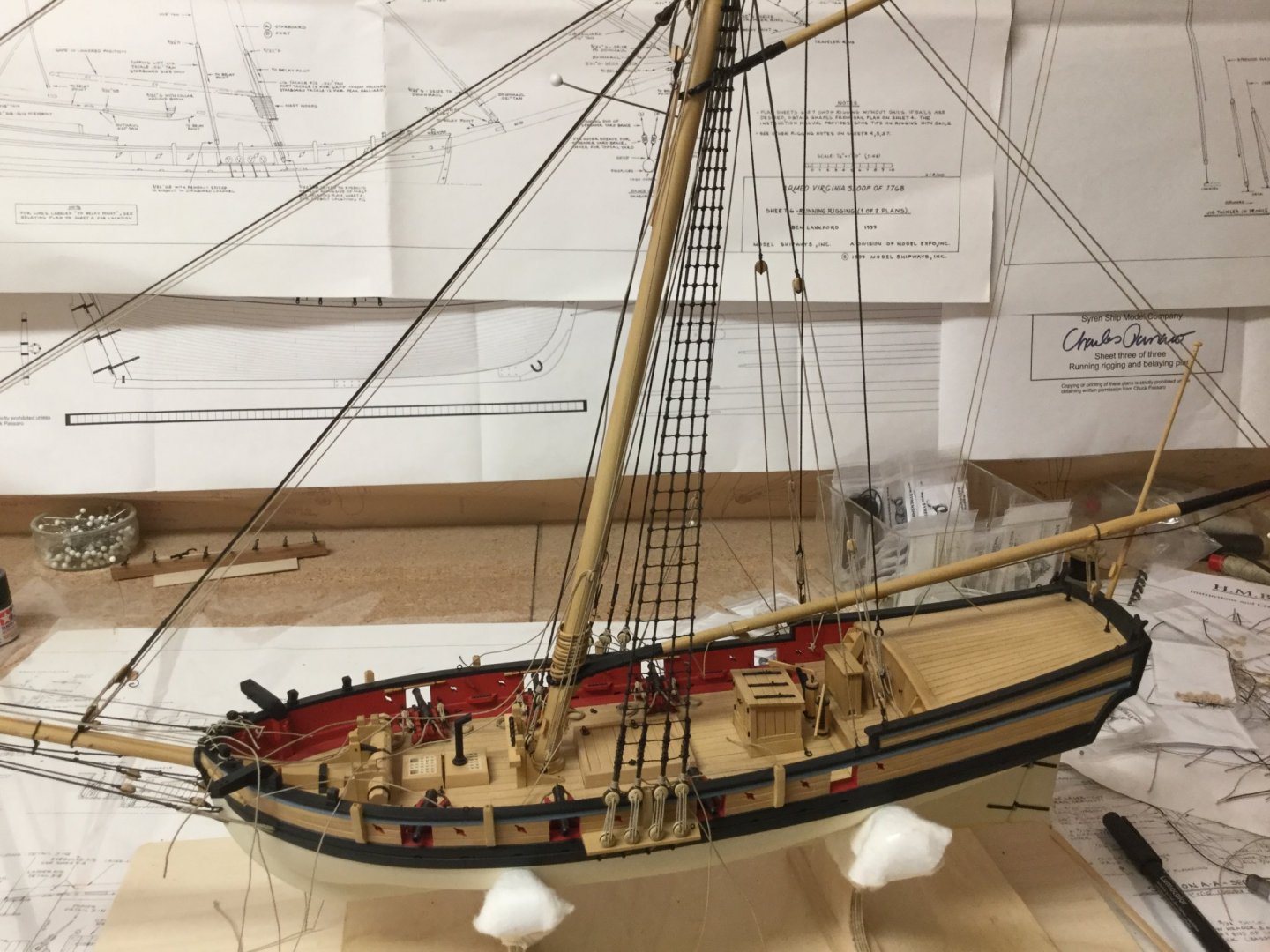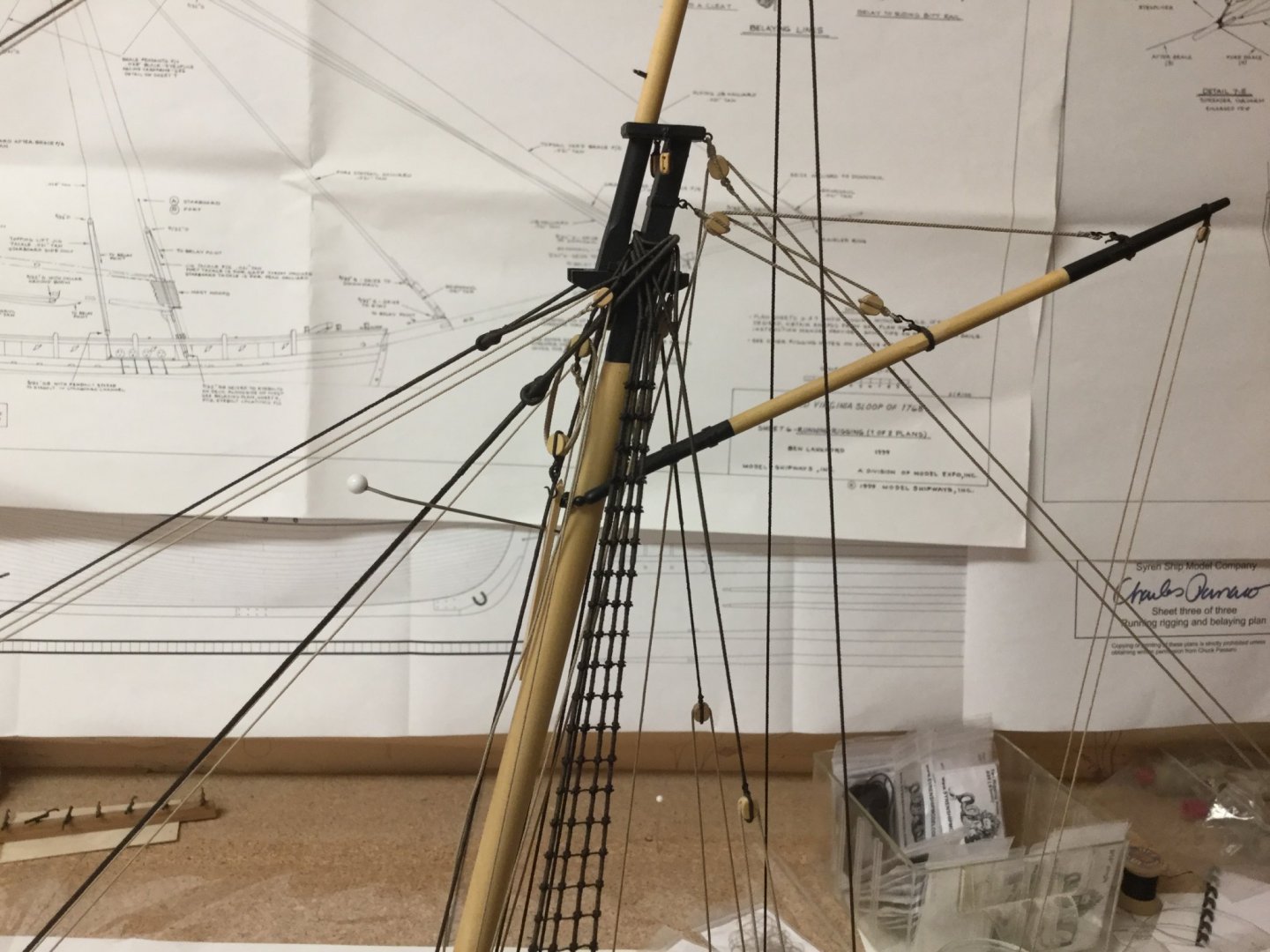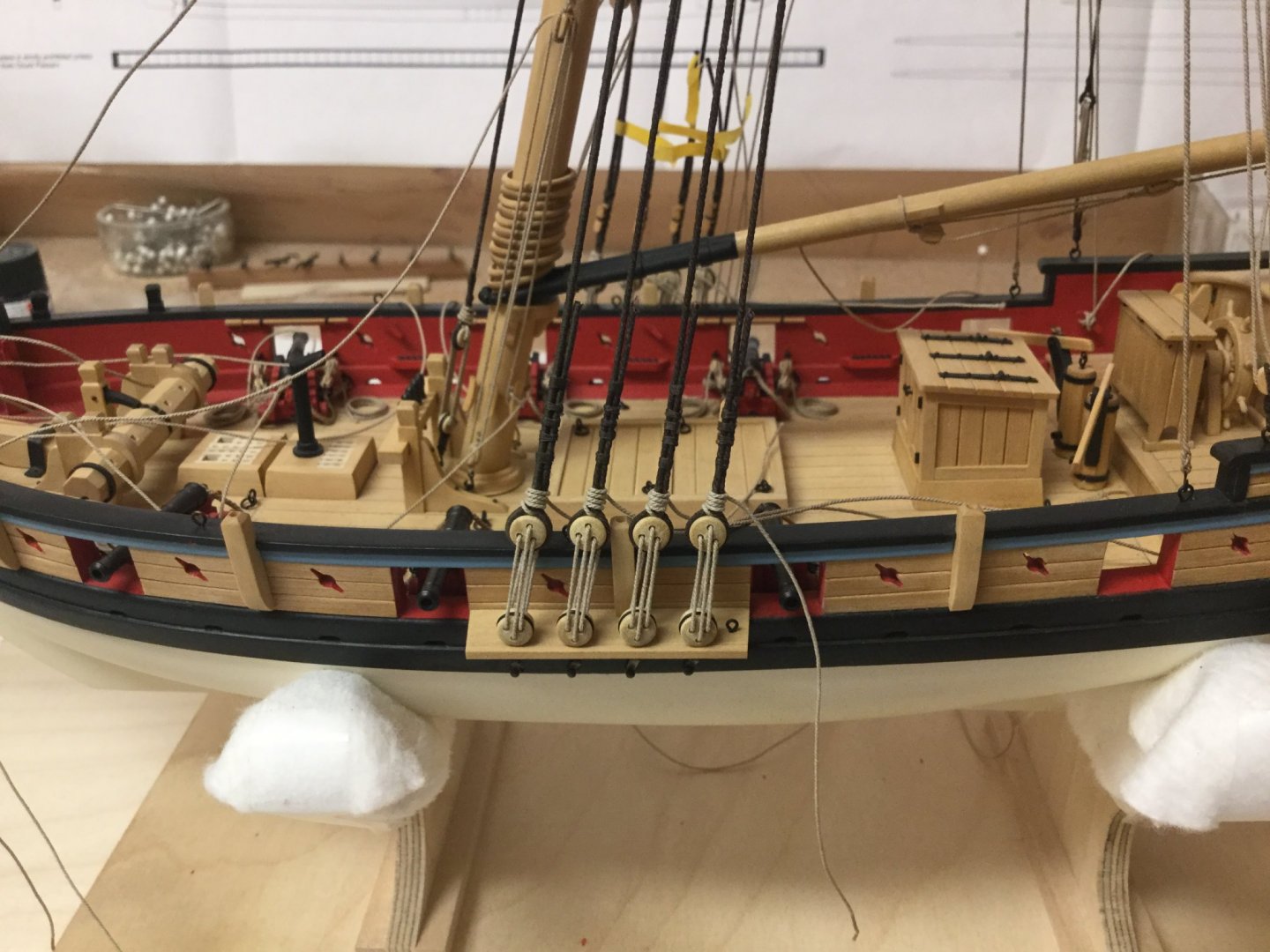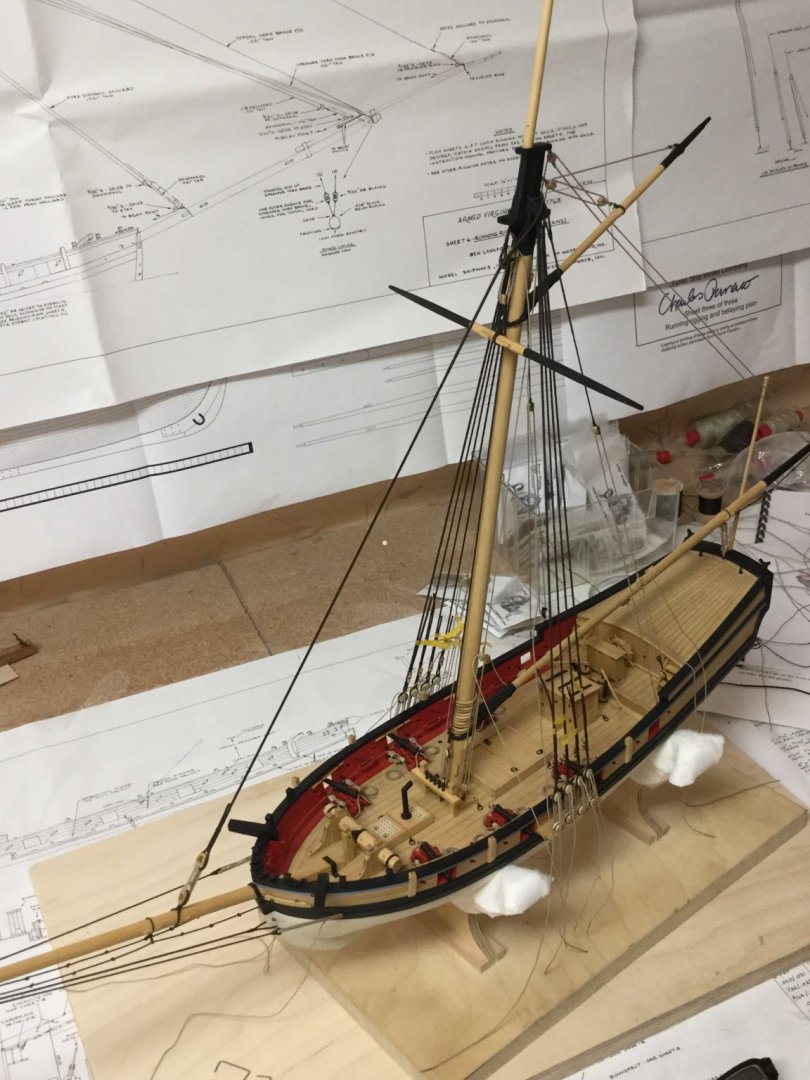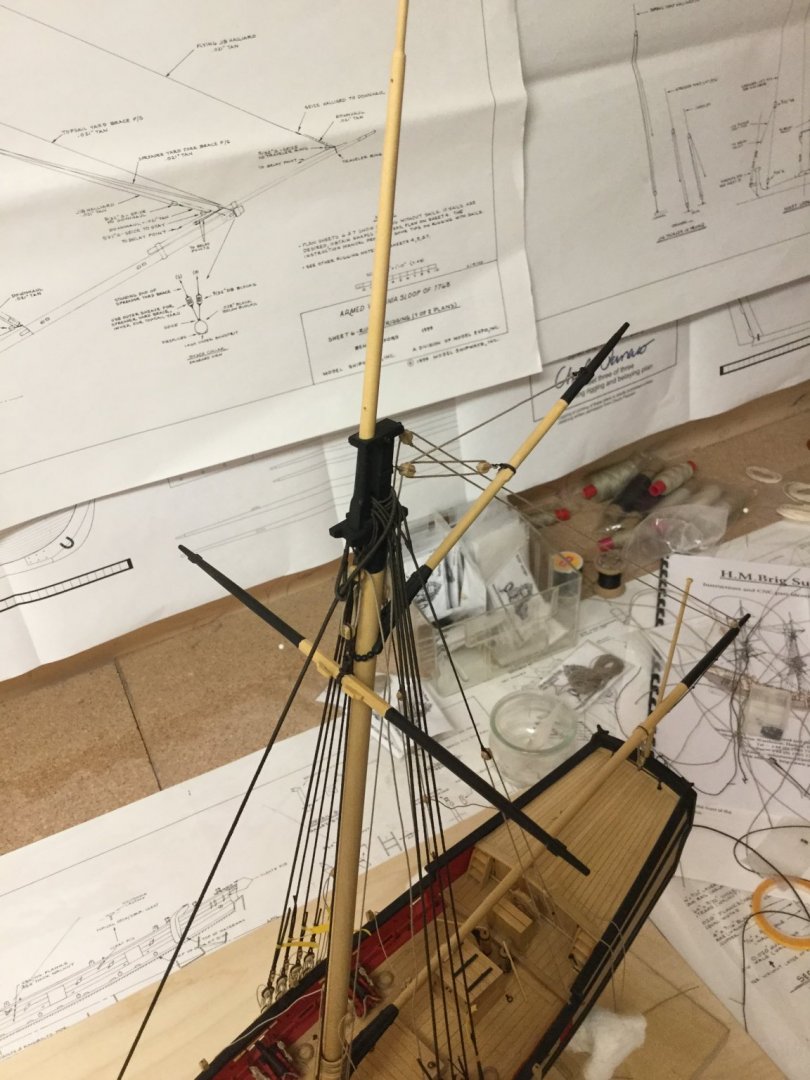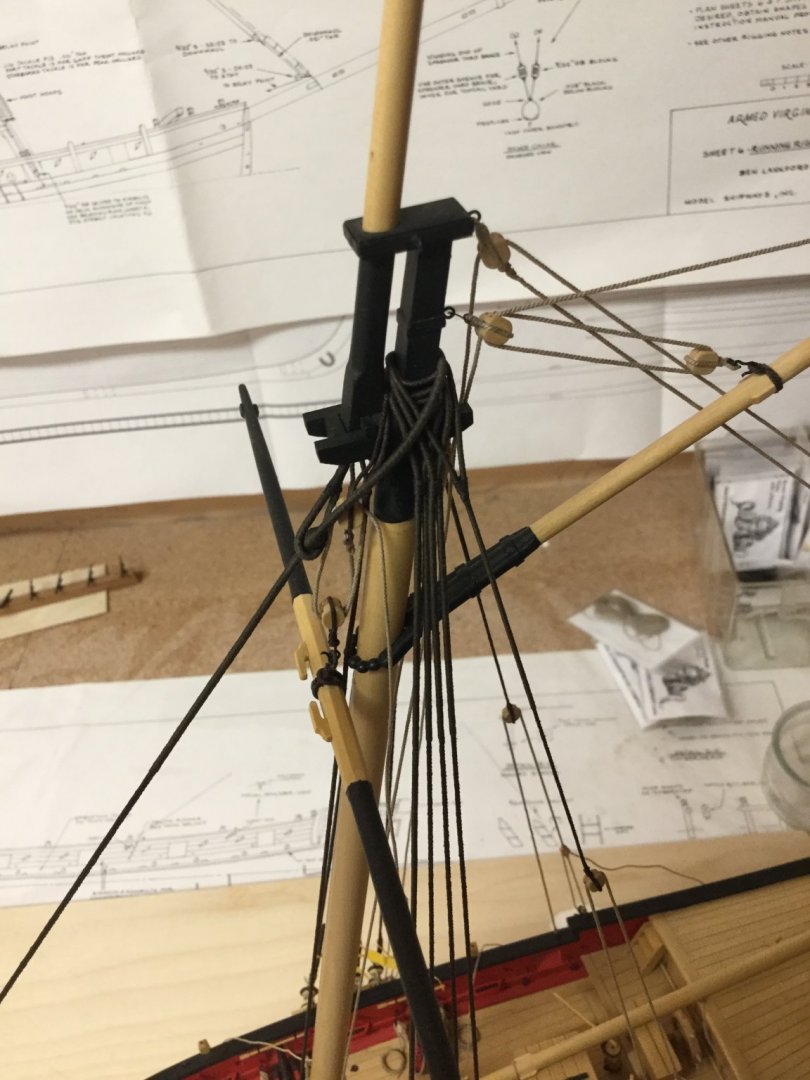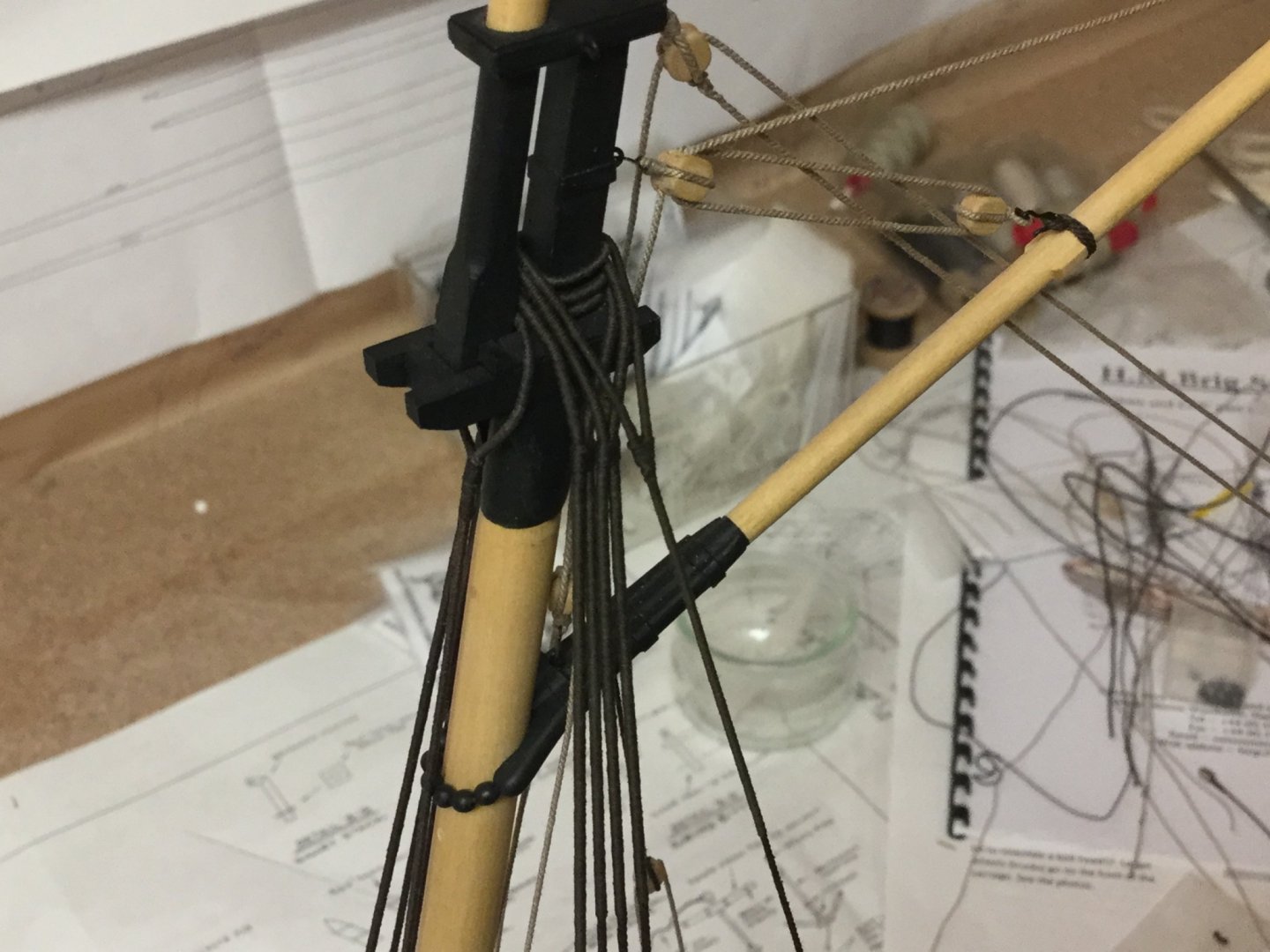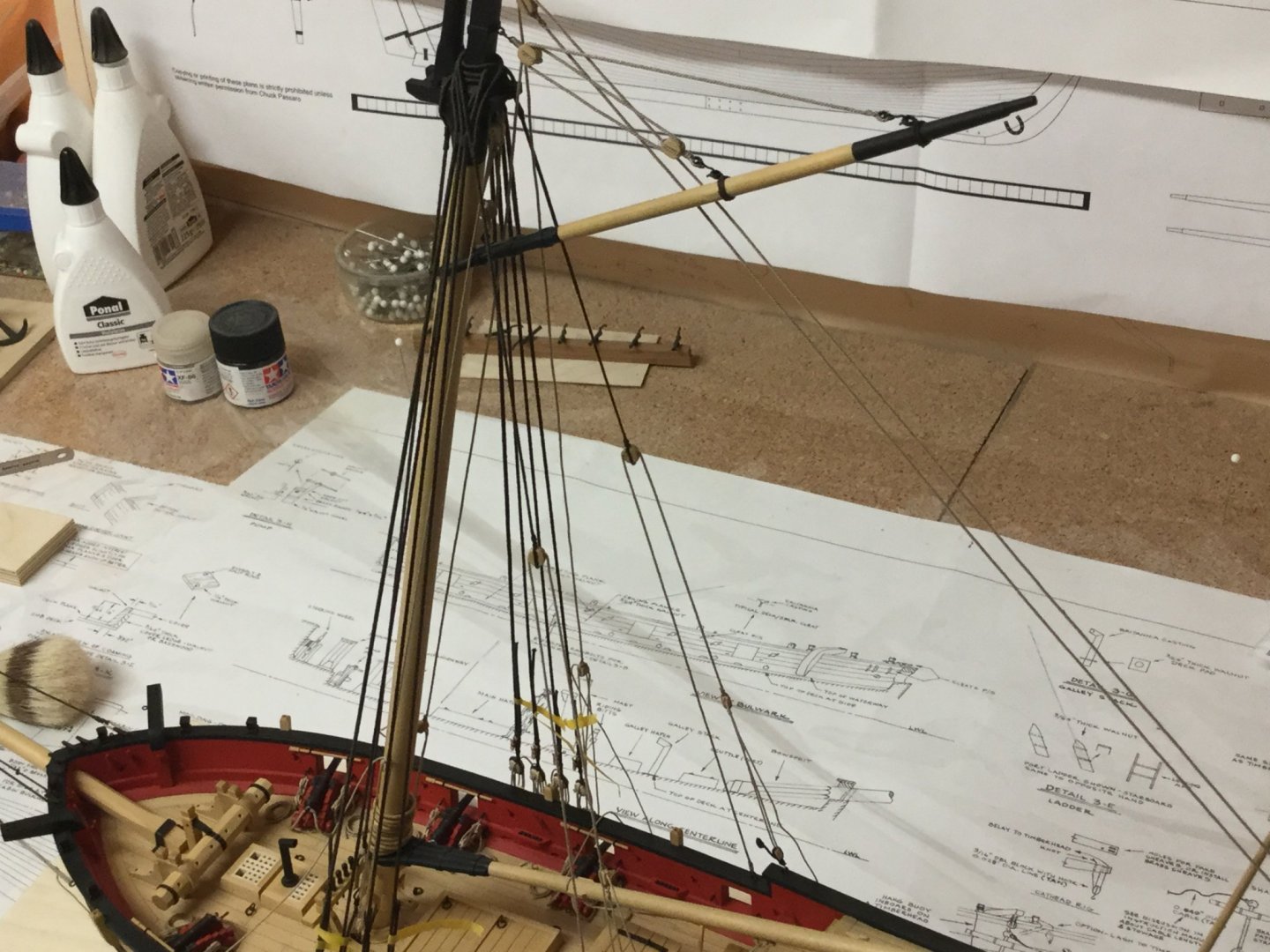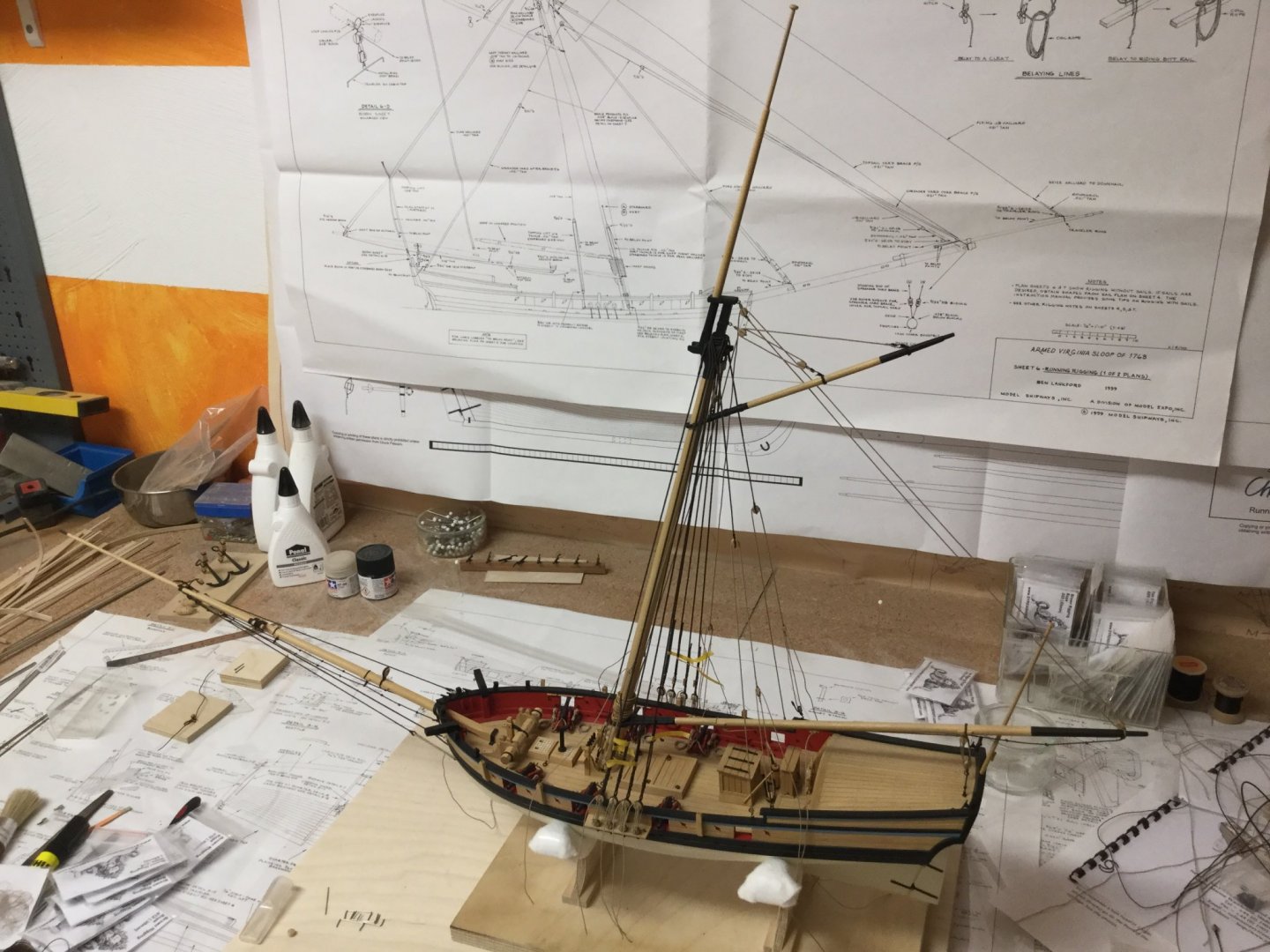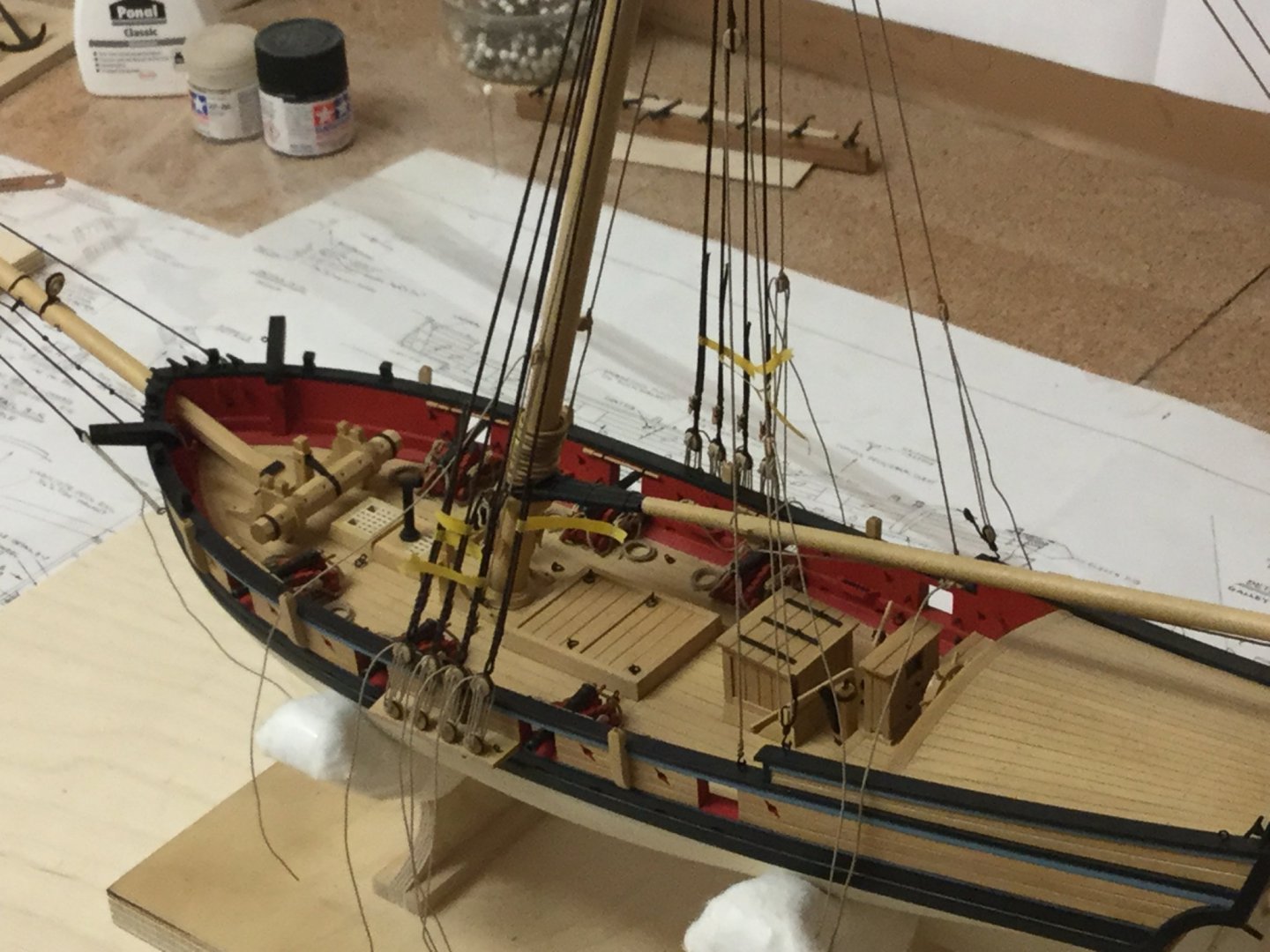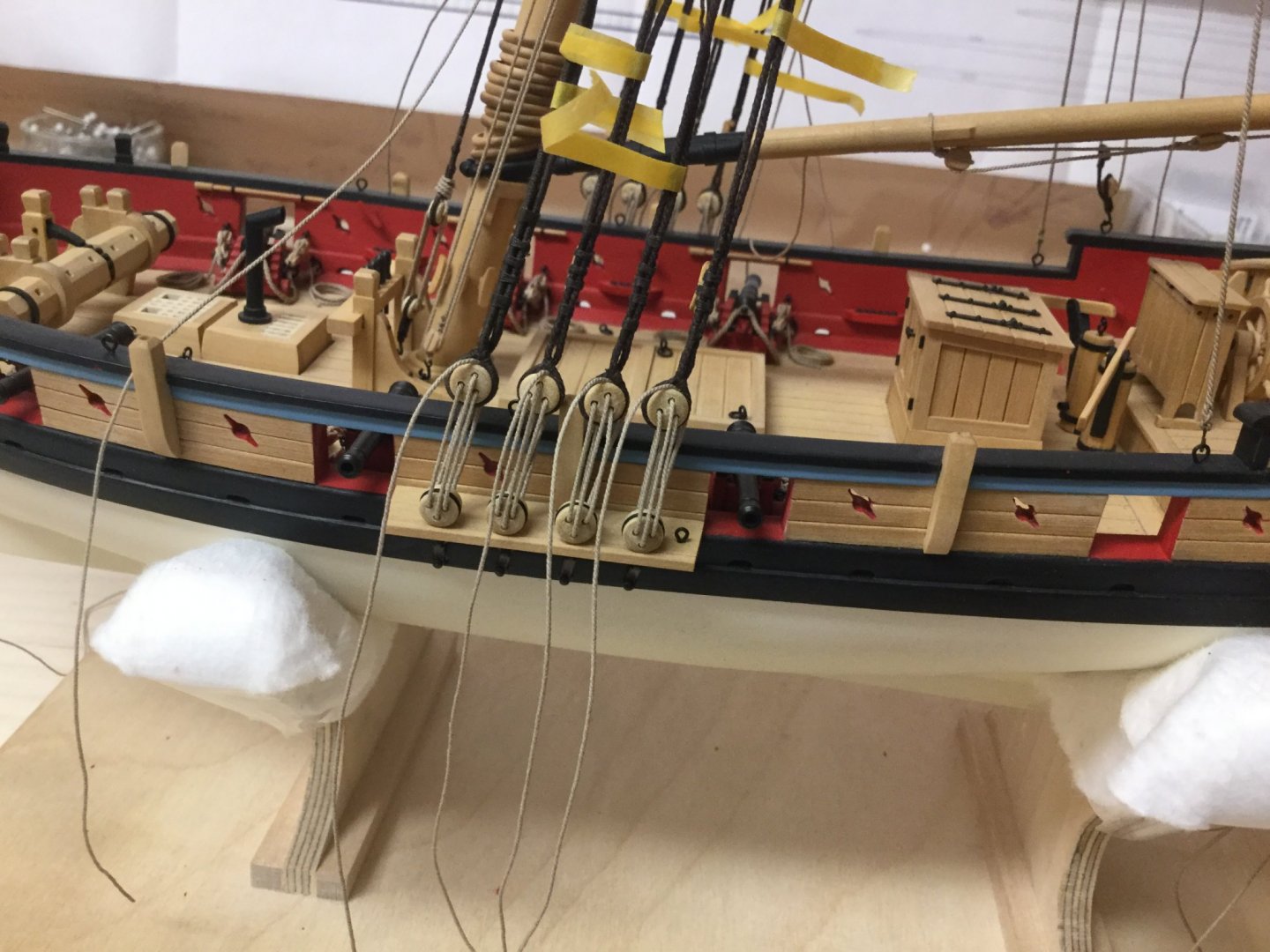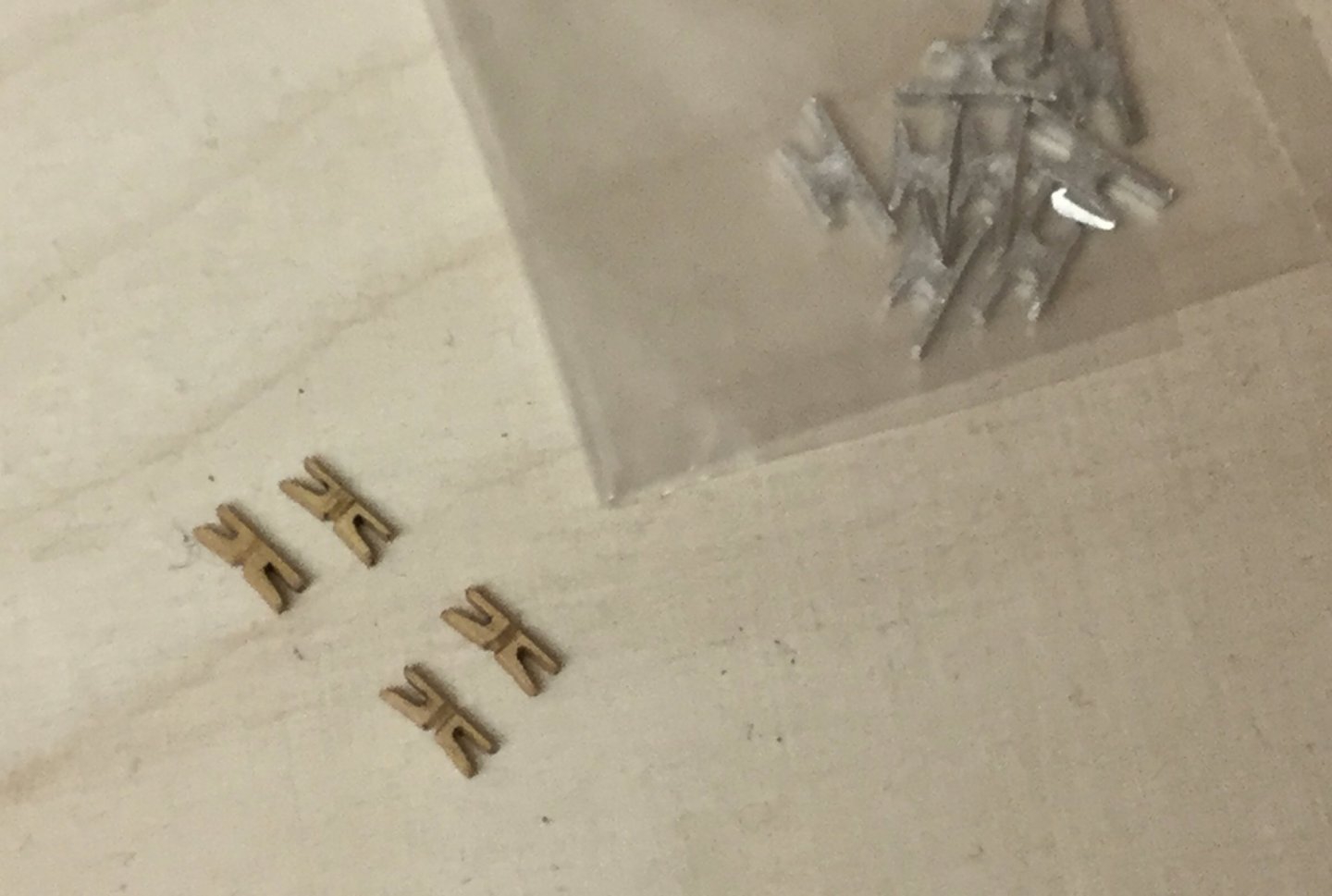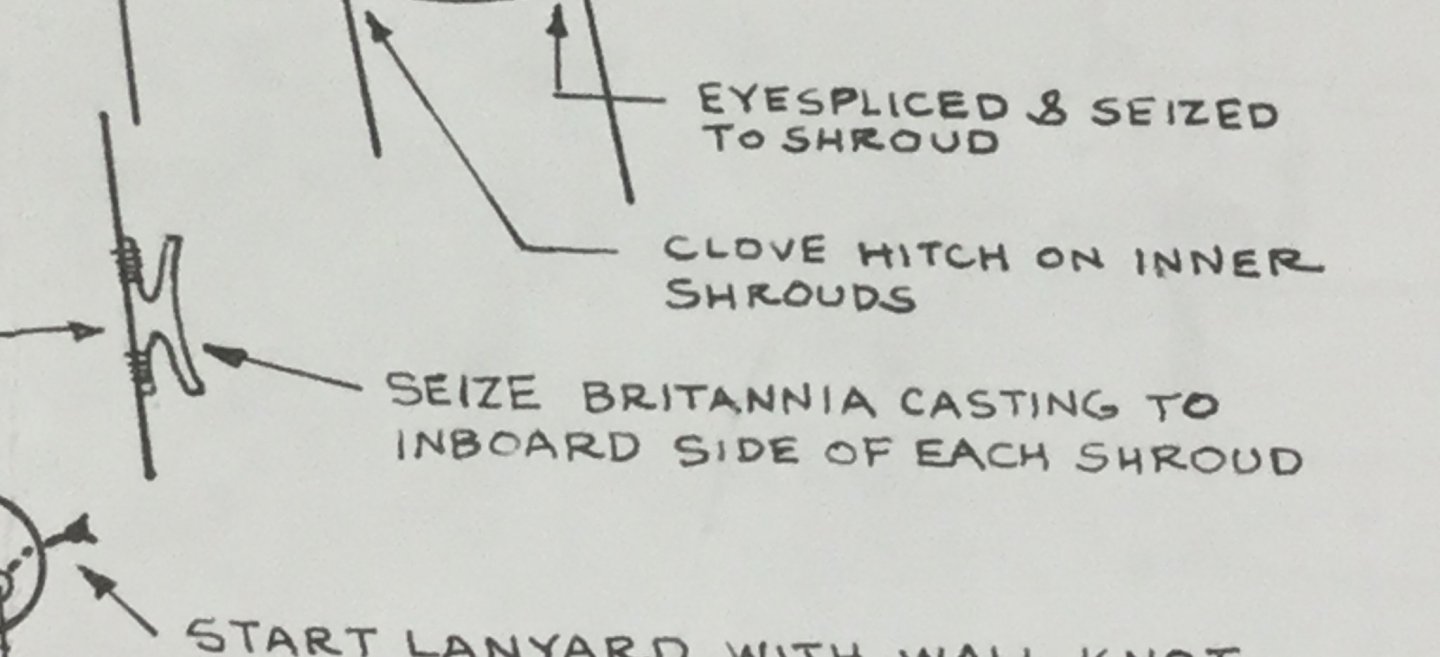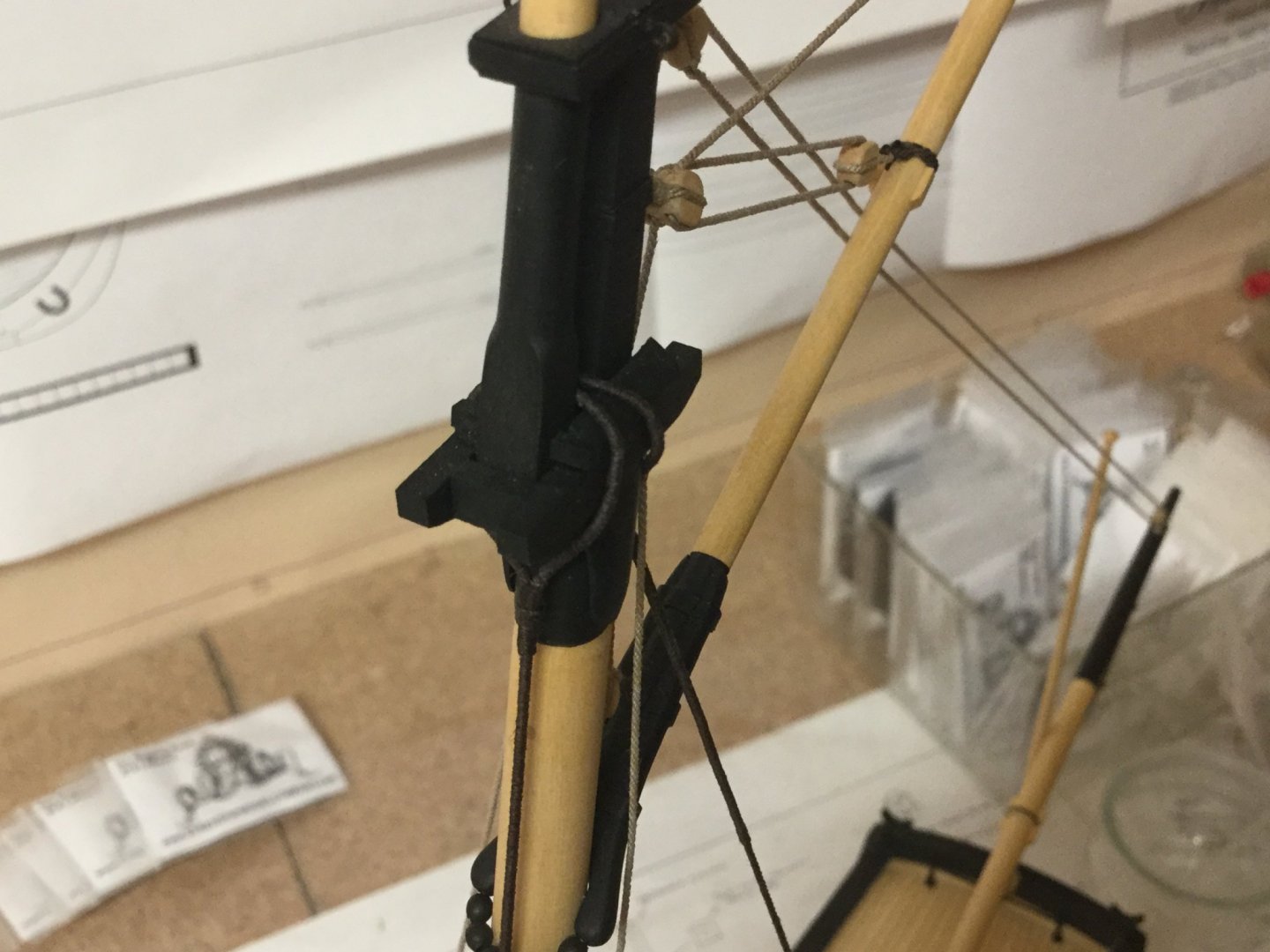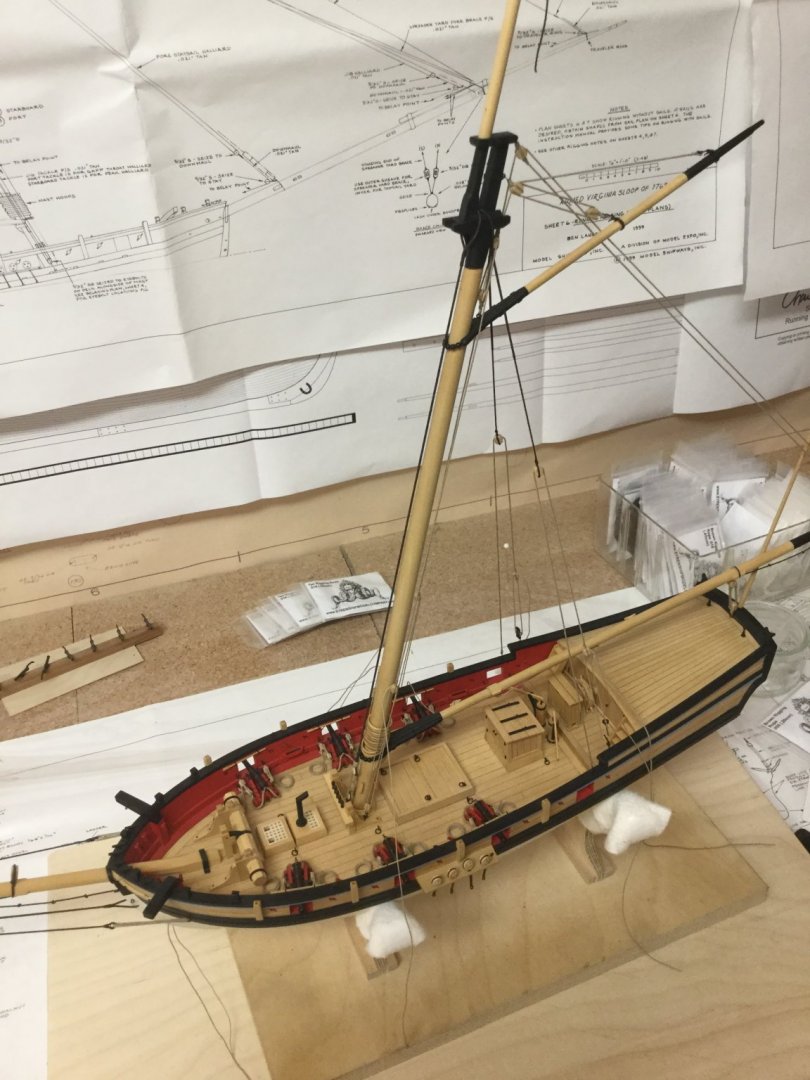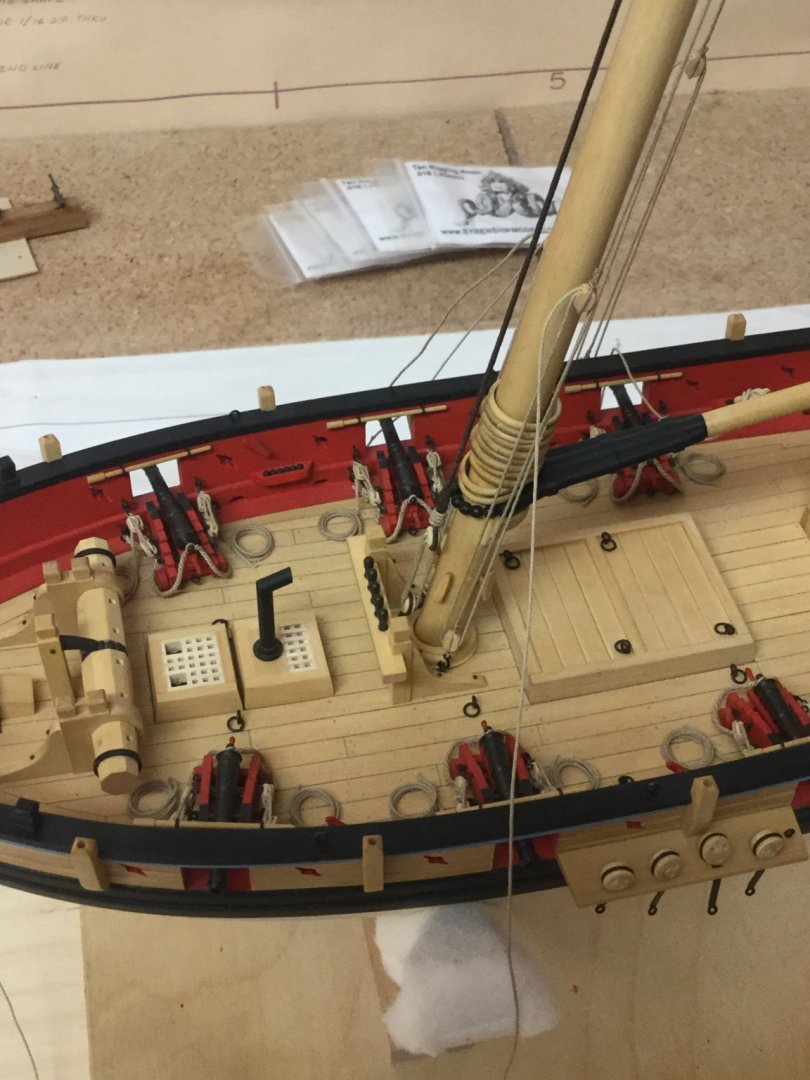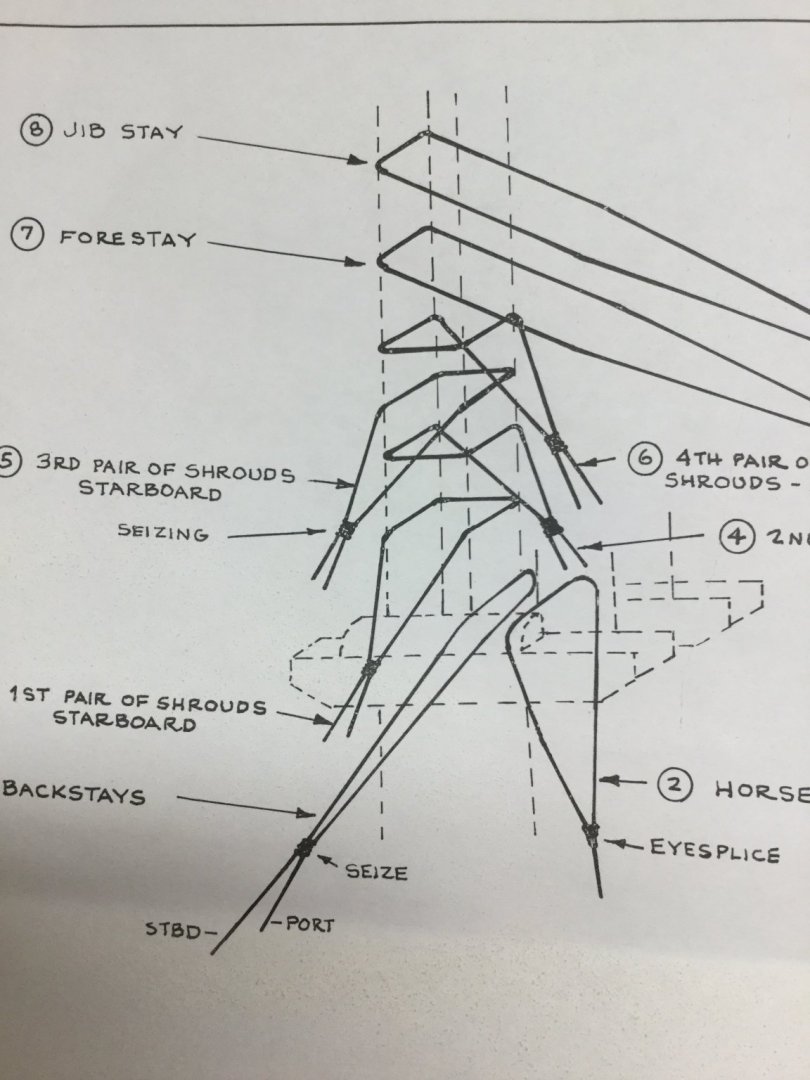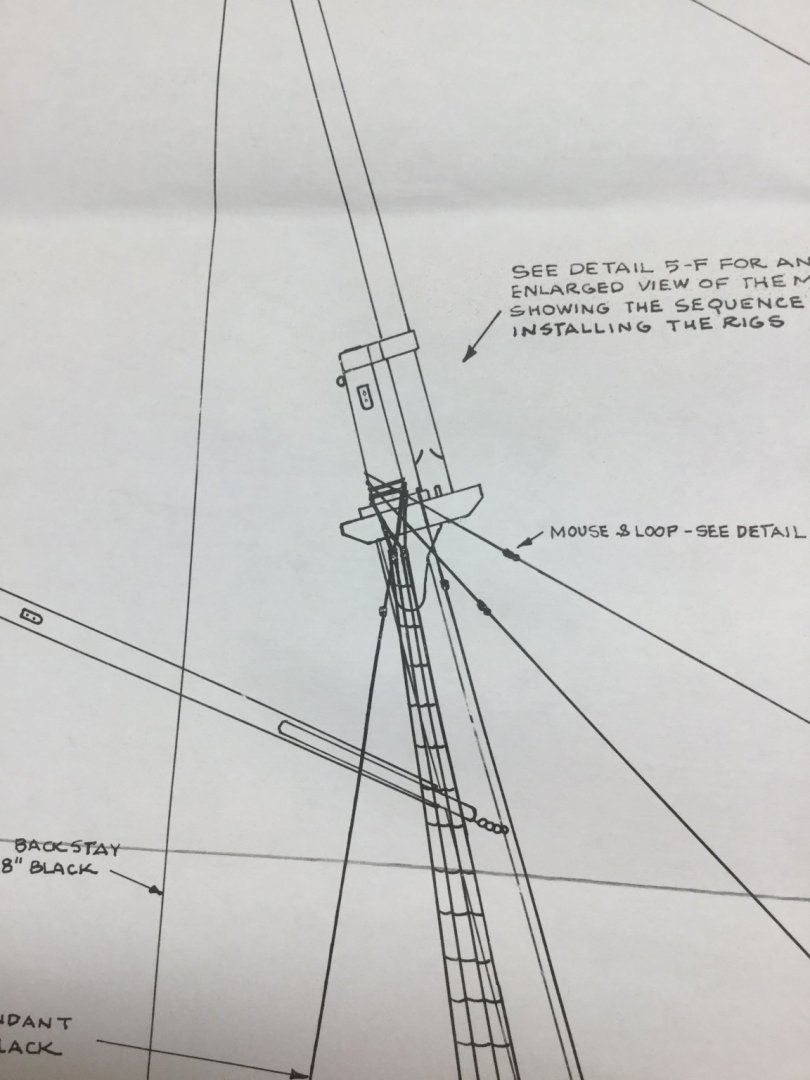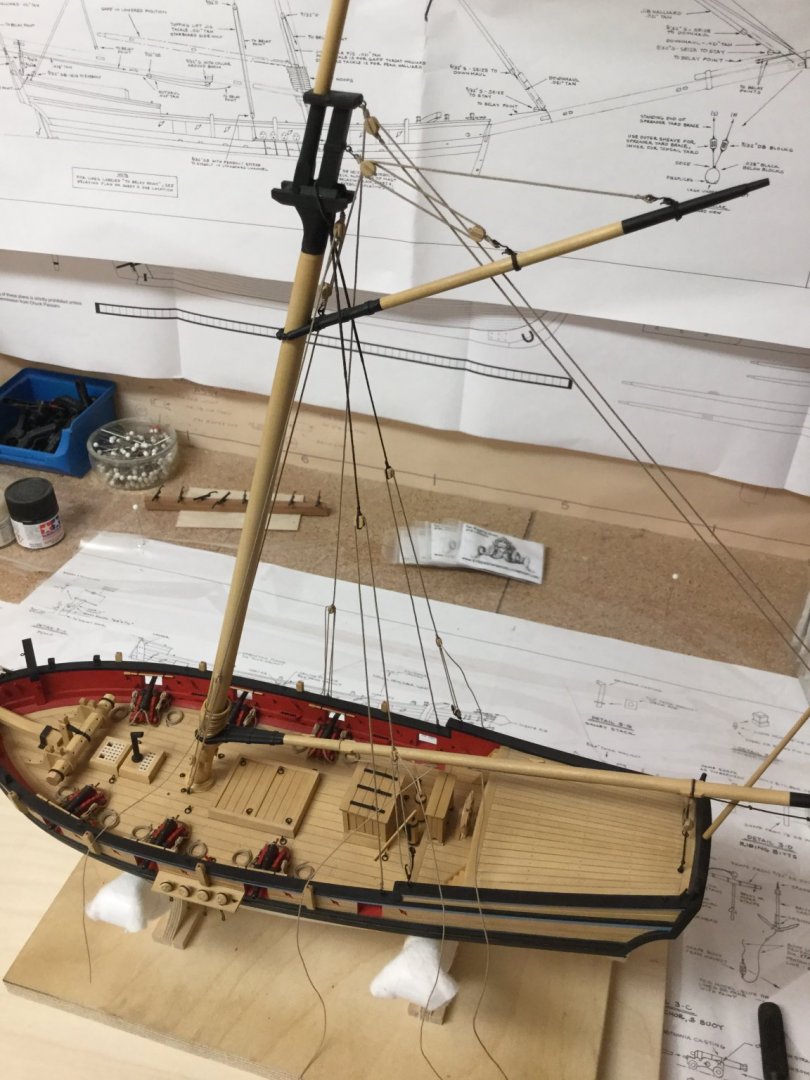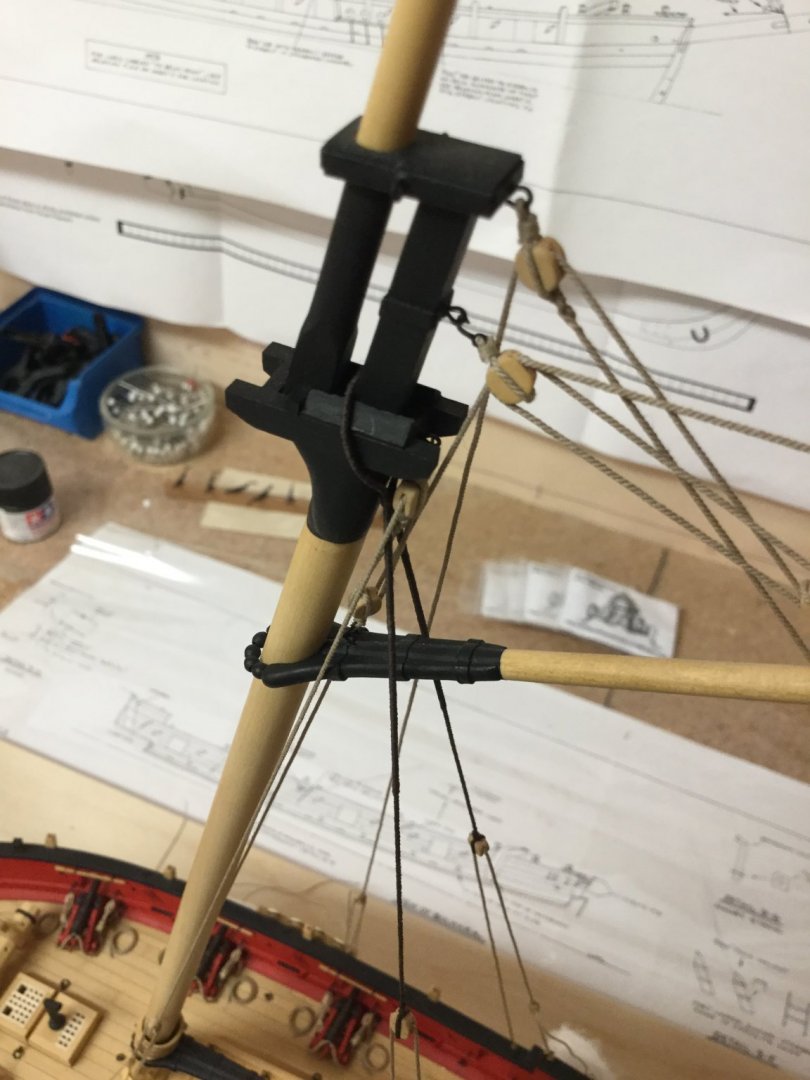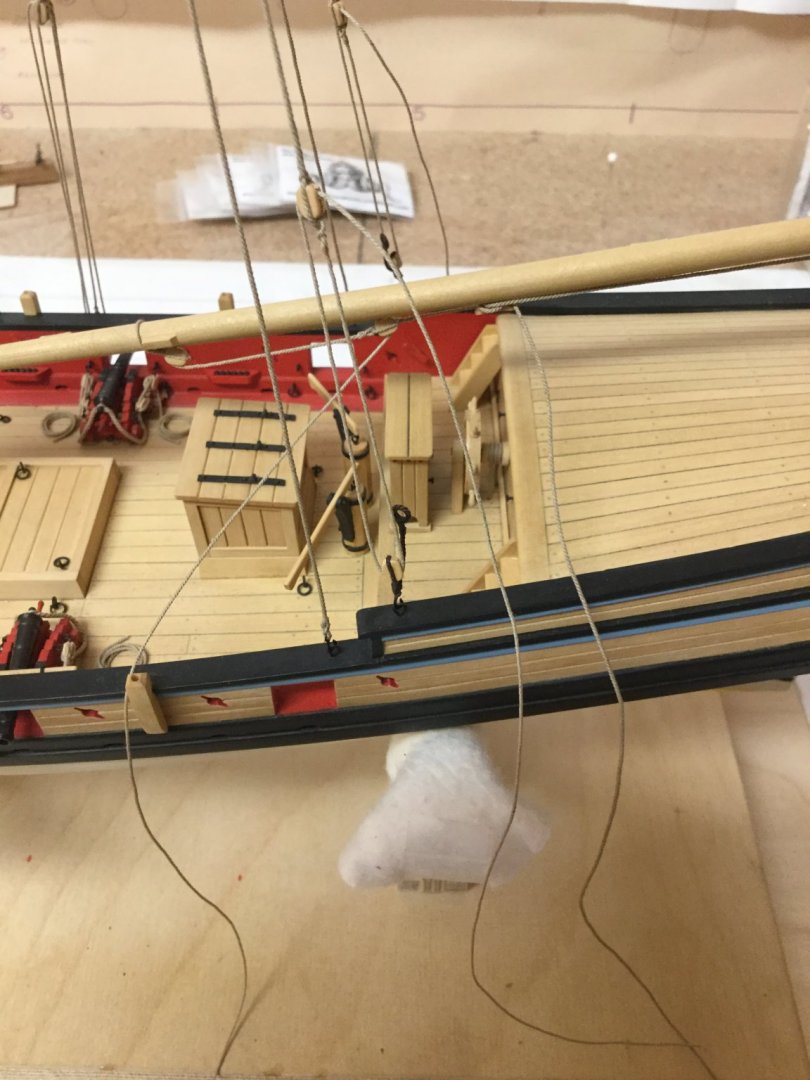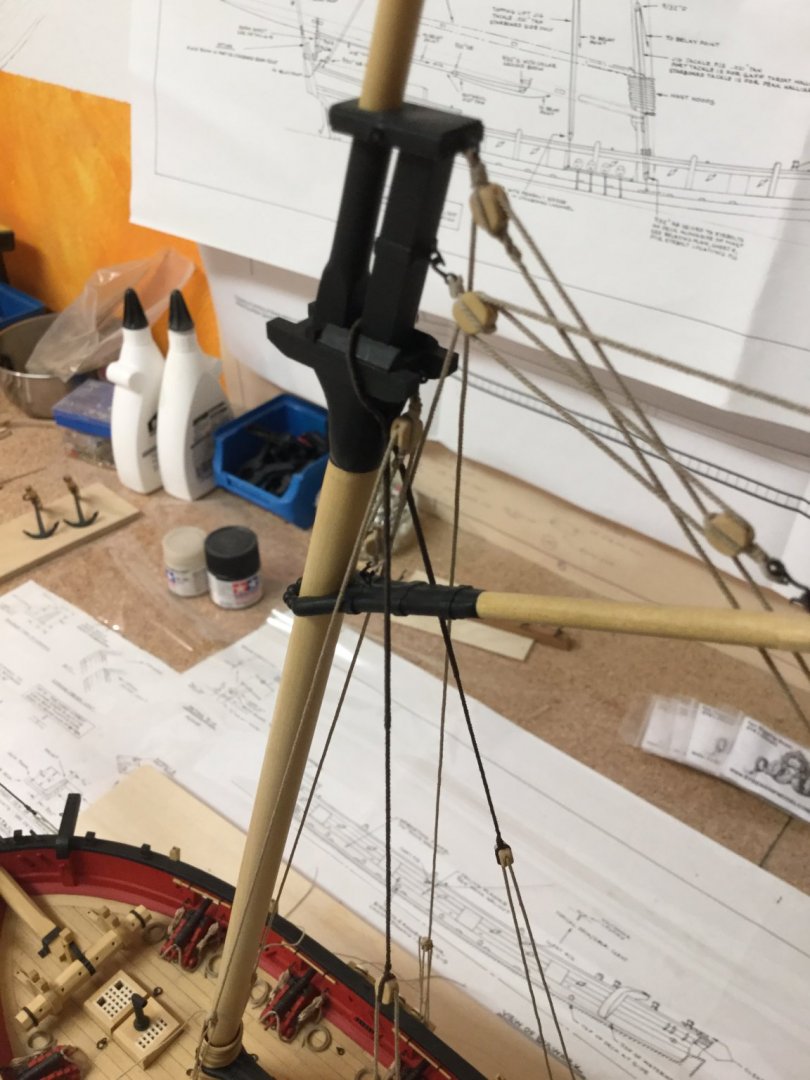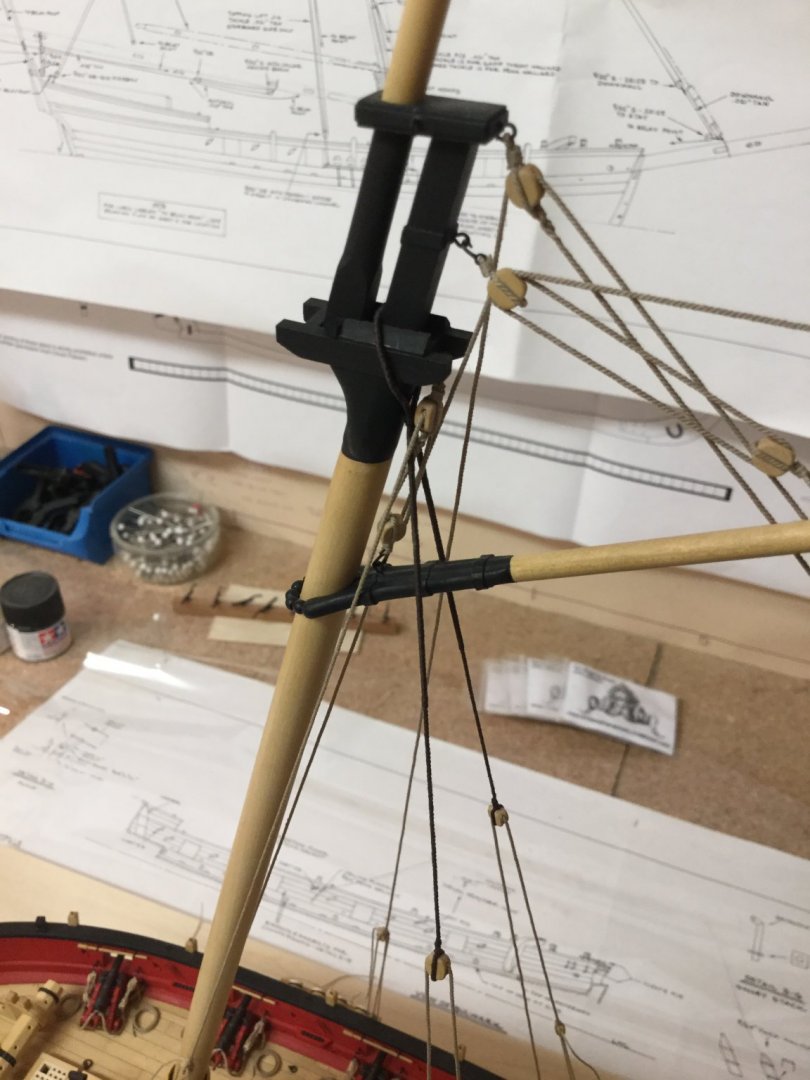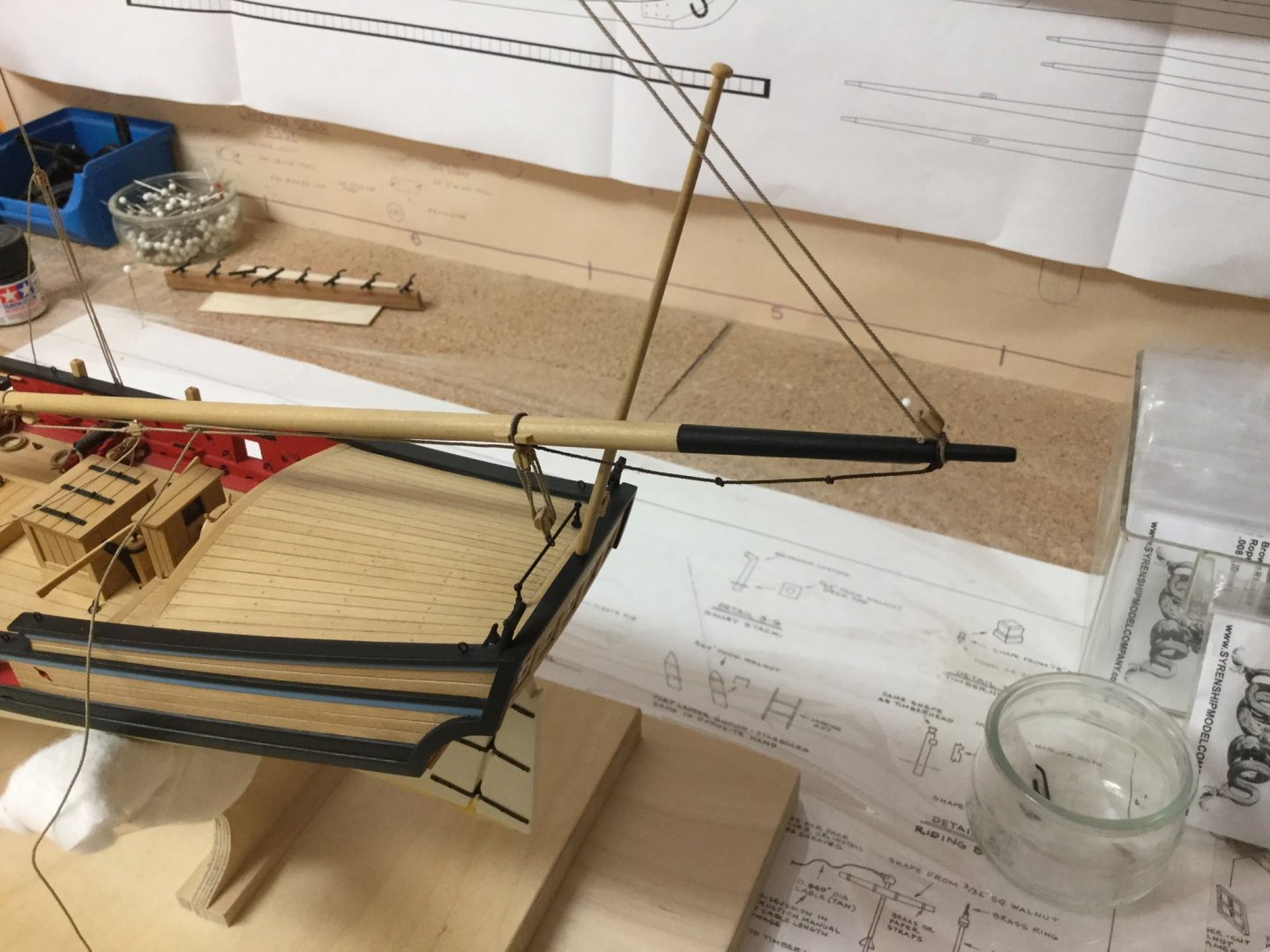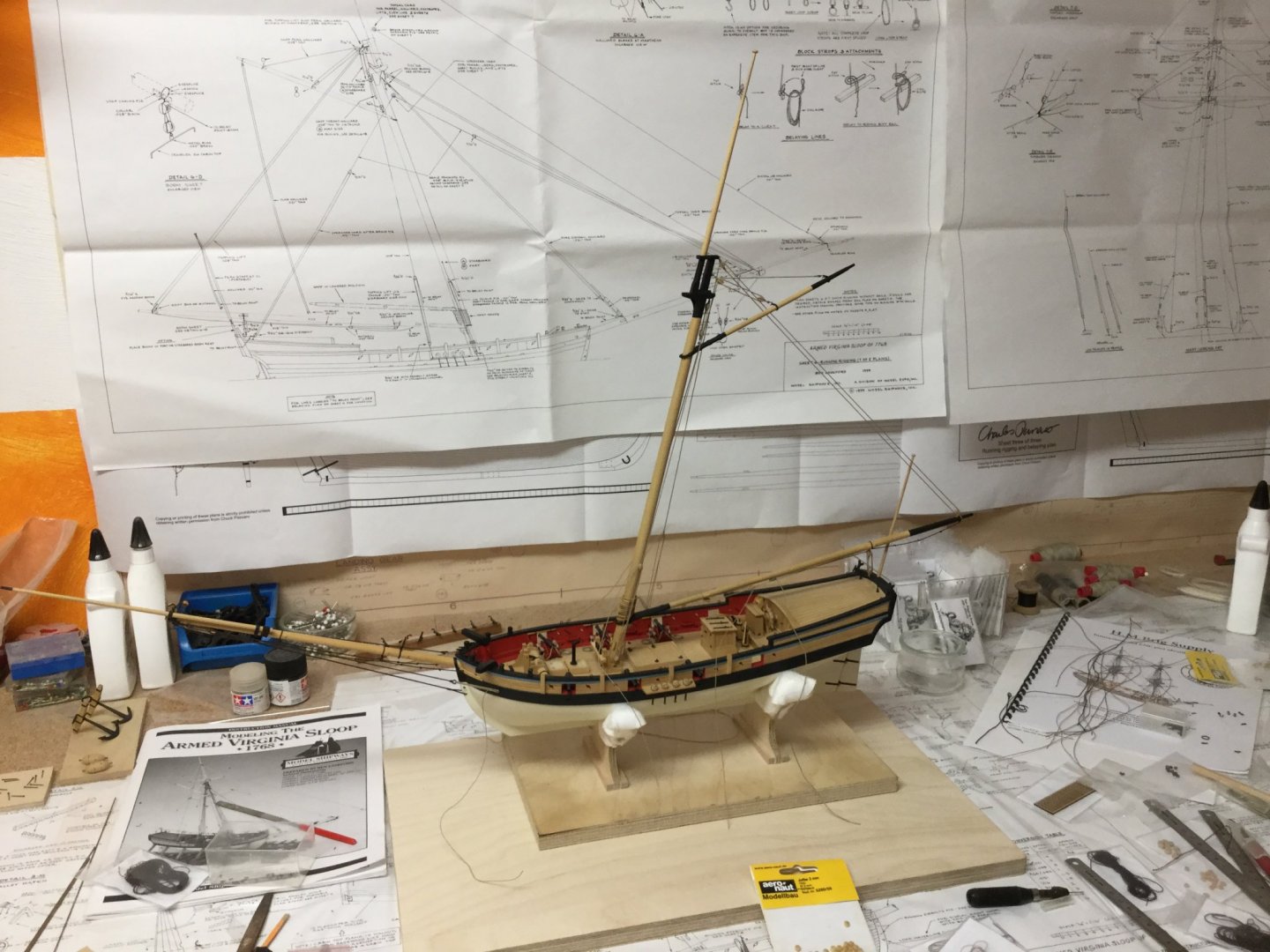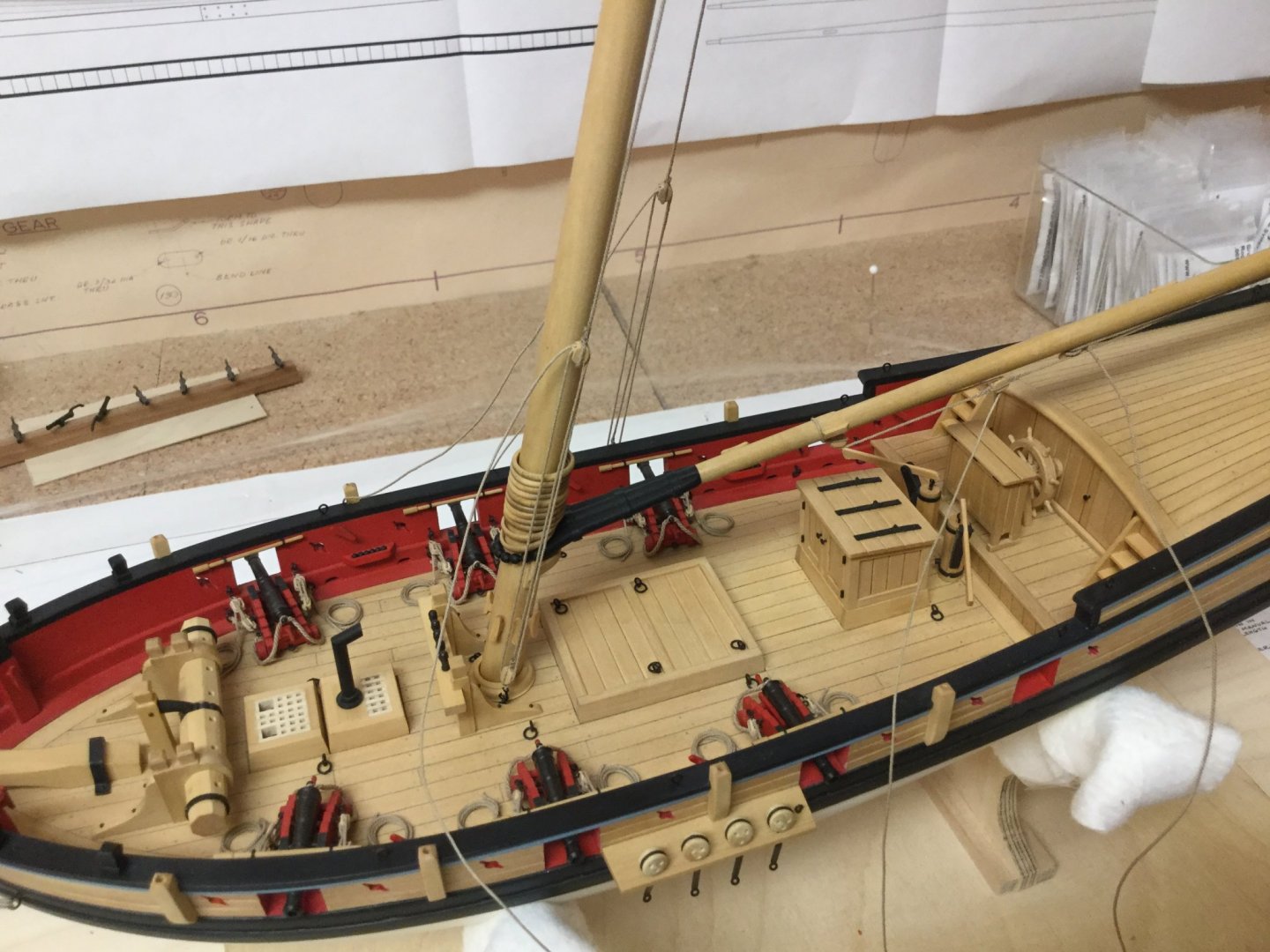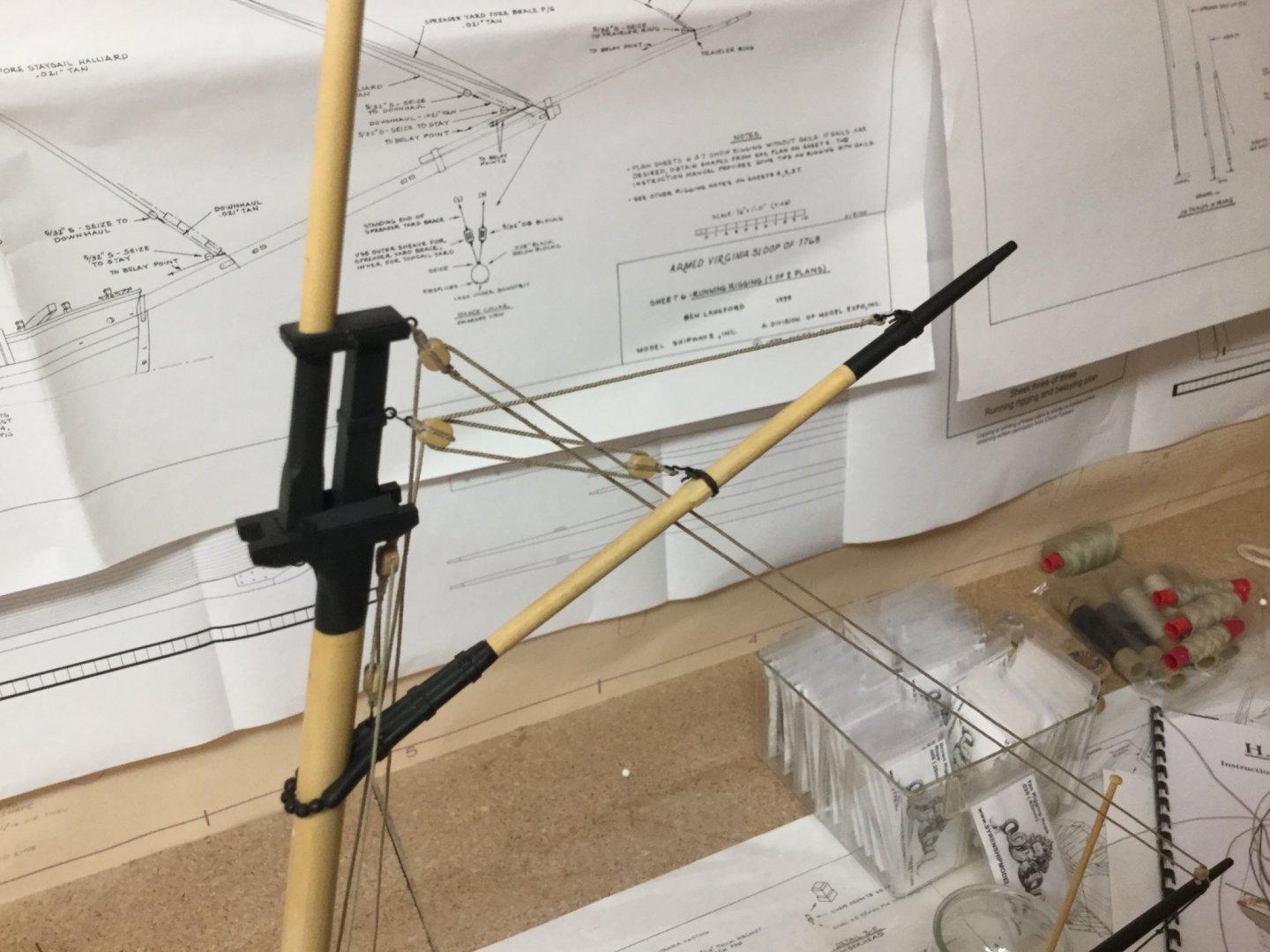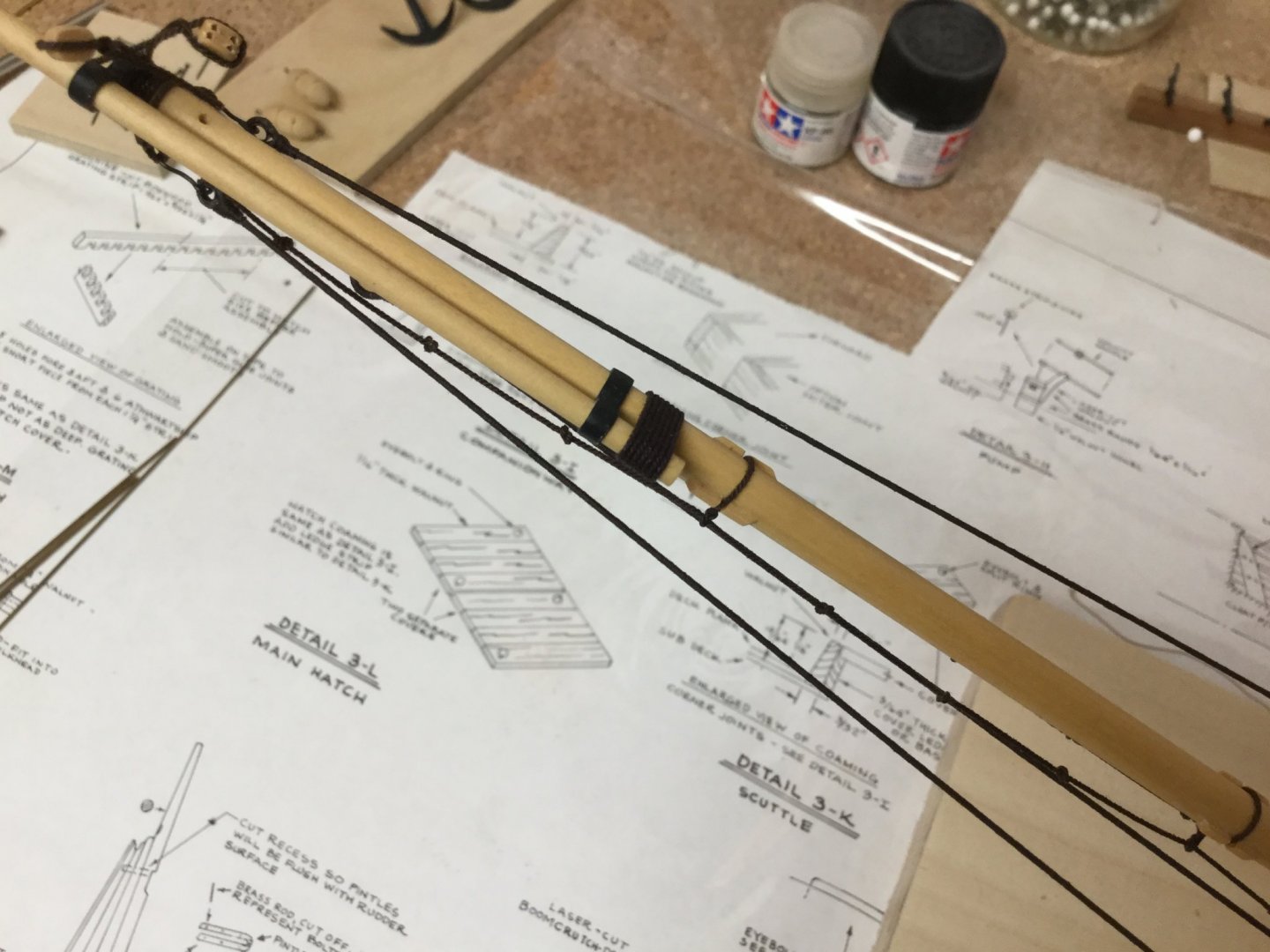-
Posts
685 -
Joined
-
Last visited
Content Type
Profiles
Forums
Gallery
Events
Everything posted by captain_hook
-
Thank you for the nice comments and likes. Some more work on the topyard. The rigging is very time-consuming, today I haven‘t done half of the things I wanted to. But the ship is stuffed with different kind of tackles, jigs etc. If you‘re looking for some special kind of rigging - the AVS surely has it...
- 231 replies
-
- model shipways
- armed virginia sloop
-
(and 1 more)
Tagged with:
-
Thank you Jean-Paul. Lower yard is finished and test-fitted. All the remaining rigging will be done in the next 2 days.
- 231 replies
-
- model shipways
- armed virginia sloop
-
(and 1 more)
Tagged with:
-
Upper yard parrel is installed. Served the rope and used .08 brown rope lashing on one side. Three days break and then I will turn on the lower yard. Started this build on 12/30/2016 and hope to finish it before 12/30/2019. And BTW - I wish everyone on MSW a merry christmas. 🎄
- 231 replies
-
- model shipways
- armed virginia sloop
-
(and 1 more)
Tagged with:
-
- 231 replies
-
- model shipways
- armed virginia sloop
-
(and 1 more)
Tagged with:
-
Before I will continue with rigging the yards, I took a break to make the swivel guns. The supplied ones are made of Britannia casting and I substituted them with syren 1/4 scale swivel guns. Soldered two metal stripes together to make the holding and drilled a 0.8mm into the gun to add the handle. The handle was made from 2mm brass rod. The kit-supplied gun is shown in the lower left corner. I then test-fitted two guns on the ship.
- 231 replies
-
- model shipways
- armed virginia sloop
-
(and 1 more)
Tagged with:
-
@Chuck: Thank you very much, but the honour belongs to your fine rope and accessoires 🤗. The footropes on the starboard side are finished too. 168 glove hitch knots per side and this is only a cutter-likely rigged vessel - can‘t imagine if I will keep my mind when it comes to building a two masted ship. Anyway that completes the standing rigging. Will turn on the yards next..
- 231 replies
-
- model shipways
- armed virginia sloop
-
(and 1 more)
Tagged with:
-
Before I do the starboard side I took a break from knoting glove hitch knots and made the traveller ring from .8mm brass wire. Used a .5mm drill to drill two holes into the ring and soldered two eyebolds to each side to rig the traveller inhauls.
- 231 replies
-
- model shipways
- armed virginia sloop
-
(and 1 more)
Tagged with:
-
Thank you for all the likes. After finishing the shrouds I started to do the ratlines. Lots of clove hitch knots. The plan calls for .021 rope for the ratlines - instead I used .012 brown syren rope. Else the ratlines would have looked way to heavy. I made a template in Corel Draw for the ratlines including the shrouds to avoid a hourglass effect. Took about 4 hours for the port side.
- 231 replies
-
- model shipways
- armed virginia sloop
-
(and 1 more)
Tagged with:
-
- 231 replies
-
- model shipways
- armed virginia sloop
-
(and 1 more)
Tagged with:
-
Hello everyone, I keep asking myself if I should rig a model so that the rope has high tension or or keep the ropes rather loose (but not hanging through) to avoid stressing splicings and seizings. What is the best compromise? Best regards, Andreas
-
- 231 replies
-
- model shipways
- armed virginia sloop
-
(and 1 more)
Tagged with:
-
I‘m working on the shrouds, have installed the shroud clamps and the laynards but only dry fitted until later adjustment. The supplied shroud clamps are made of britannia casting and I substituted them with syren shrouds clamps - they look much more appropriate and scale. Decided to refit the backstays to a more common way so the running rigging now has a lot of space to run downwards.
- 231 replies
-
- model shipways
- armed virginia sloop
-
(and 1 more)
Tagged with:
-
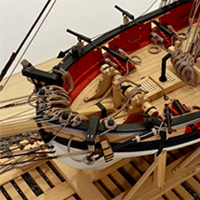
Shroud cleats and how to seize them?
captain_hook replied to captain_hook's topic in Masting, rigging and sails
Thank you very much for the pictures and information. Now I can go on installing them. Thanks a lot. -
Hello everyone, I’m building an AVS and substituted the kit supplied casting shroud cleats with syren shroud cleats. The plans tell me to seize the casting ones inbound to the shrouds on both sides (as shown in the picture). But the syren cleats do have a grove in the center that the casting ones don‘t have. Are the cleats seized to the shrouds using that grove in the center or as supposed in the plan and then - what is the grove supposed to use for? Best regards, Andreas
-

Running rigging and backstays
captain_hook replied to captain_hook's topic in Masting, rigging and sails
Thank you all for the comments and inspiration. I thought about it and will redo the backstays. Since it will be a dockyard model and gaff and boom will be centered I don‘t have to worry about the question about historical correctness of symmetrie. But as it is a model it should be optical pleasant as well and doing two single backstay pendants which lean on the sides of the mars instead of one seized together below gives me the possibility to have more space for running rigging. Thank you again. Now I have to continue with the shrouds first. -

Running rigging and backstays
captain_hook replied to captain_hook's topic in Masting, rigging and sails
@Bob Cleek: Thank you for the detailed information. I guess it is not an easy way to balance modeling design aspects and historical approved aspects. -
@SpyGlass: thank you very much. Today I did more work on the standing rigging and installed the spreader yard horse. The upper part is served over its entire length. The shrouds are next, I consider that the hardest part of the rigging.
- 231 replies
-
- model shipways
- armed virginia sloop
-
(and 1 more)
Tagged with:
-

Running rigging and backstays
captain_hook replied to captain_hook's topic in Masting, rigging and sails
Thank you, Everest and Dubz. I used the C. Feldman book for reference and it seems Model Expo also did because they refer more than once in their manual to the model build by Feldman. AFAIK Feldman used plans from the Smithsonian Institution and personal research as reference so I assume his rigging scheme is based at least on historical probability. In the Feldman book the backstays are also mentioned as „running backstays“ and their function maybe differ from the cutter-rig (i.e. cheerful), where backstays are more permanently fixed for mast stability. Otherwise the AVS-rig includes topmast-backstays which are missing in the cutter-rig (if I remember that correctly). -

Running rigging and backstays
captain_hook replied to captain_hook's topic in Masting, rigging and sails
Thank you for the explanation. I agree that the gaff has almost no space to move. So the rigging plan of the kit is wrong in this case? I made 2 photos of the rigging plan segments showing the backstays, I‘ve done them like shown on the plan. -
Started the standing rigging with the backstays. I‘m not sure if the gaff throat and peak halliards (I mean the part that goes down to the tackles) run inside or outside the backstays, the instructions and the plans give no hints. Any suggestions would be very helpful. Fortunately I have used hooks to attach the blocks so I can change them if necessary.
- 231 replies
-
- model shipways
- armed virginia sloop
-
(and 1 more)
Tagged with:
-
Thank you Bill, that is a very useful tip.
-
Hello, I‘m working on an armed Virginia sloop (1-mast cutter-like rig) and wonder if the running rigging (especially gaff throat halliard and gaff peak halliard) run inside the backstays or outside. I mean the segment that goes down to the tackles (sorry, I‘m limited to school english - we didn‘t discuss much about age of sail in german school). My intuition says yes but I have done it otherwise - it just didn‘t look right. Thank god I have used hooks to attach the blocks. Best regards, Andreas
-
Thank you very much. I made some more progress, starting to do some running rigging on gaff and boom. As Chuck Passaro said in the cheerful build log, it is easier to do this at this stage as all areas are still accessable. Used some hooks on the gaff, a nice little detail I saw in the cheerful log. The tackles are done but the belay points are not available yet so I have to wait with the last step. Did the heel lashing too, almost forgot that. Next will be doing the standing rigging ... next weekend.
- 231 replies
-
- model shipways
- armed virginia sloop
-
(and 1 more)
Tagged with:
About us
Modelshipworld - Advancing Ship Modeling through Research
SSL Secured
Your security is important for us so this Website is SSL-Secured
NRG Mailing Address
Nautical Research Guild
237 South Lincoln Street
Westmont IL, 60559-1917
Model Ship World ® and the MSW logo are Registered Trademarks, and belong to the Nautical Research Guild (United States Patent and Trademark Office: No. 6,929,264 & No. 6,929,274, registered Dec. 20, 2022)
Helpful Links
About the NRG
If you enjoy building ship models that are historically accurate as well as beautiful, then The Nautical Research Guild (NRG) is just right for you.
The Guild is a non-profit educational organization whose mission is to “Advance Ship Modeling Through Research”. We provide support to our members in their efforts to raise the quality of their model ships.
The Nautical Research Guild has published our world-renowned quarterly magazine, The Nautical Research Journal, since 1955. The pages of the Journal are full of articles by accomplished ship modelers who show you how they create those exquisite details on their models, and by maritime historians who show you the correct details to build. The Journal is available in both print and digital editions. Go to the NRG web site (www.thenrg.org) to download a complimentary digital copy of the Journal. The NRG also publishes plan sets, books and compilations of back issues of the Journal and the former Ships in Scale and Model Ship Builder magazines.

